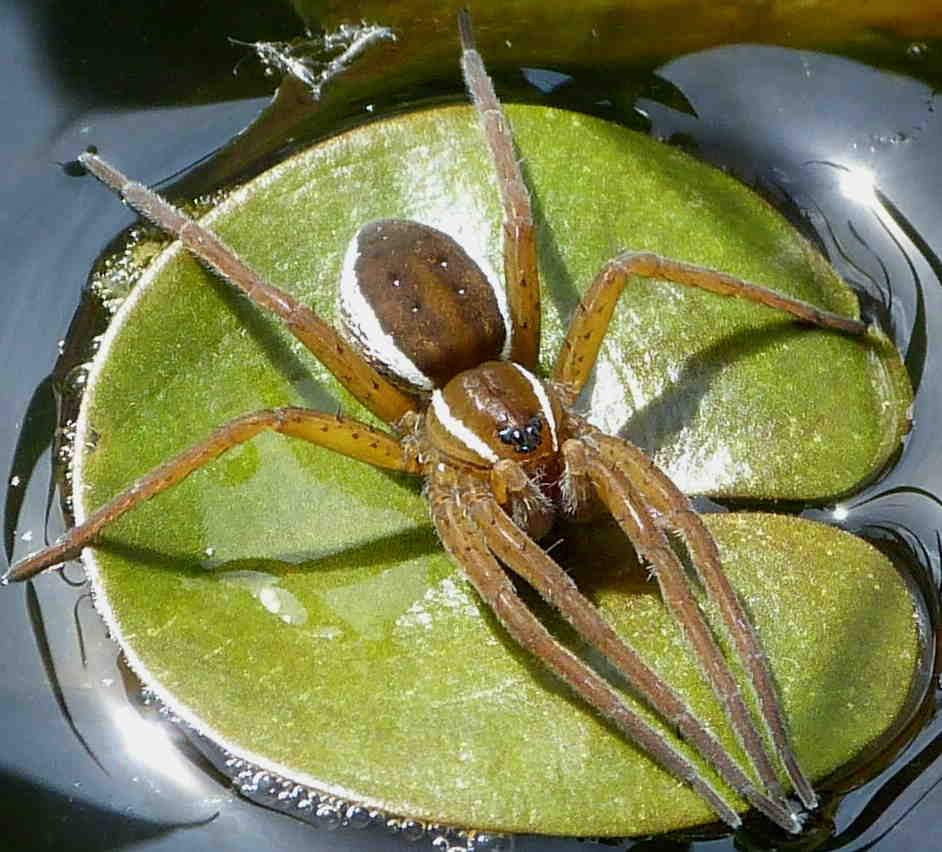Courtship
Water plays a vital role in courtship and breeding, as well as in hunting and locomotion, in Dolomedes plantarius. Apparently very isolated adult females are usually found by courting males, suggesting that the chemo-sensory system is important for mate location at distance. It is not known whether any pheromone transmission can take place through the air over these distance but, in closer proximity, males can be seen following the pheromone-impregnated silk drag-lines of females, repeatedly touching them with their palps (see James Dunbar's footage of courtship). This explains the often apparently random tracks followed by males as they approach a female. As the male approaches more closely, the mechano-sensory system becomes key and an often protracted courtship ritual begins. This usually involves the male in making numerous careful approaches across the water surface towards the female, vibrating his front legs alternately in delicate arcs across the meniscus, often also moving his abdomen from side-to-side and bobbing his whole body.
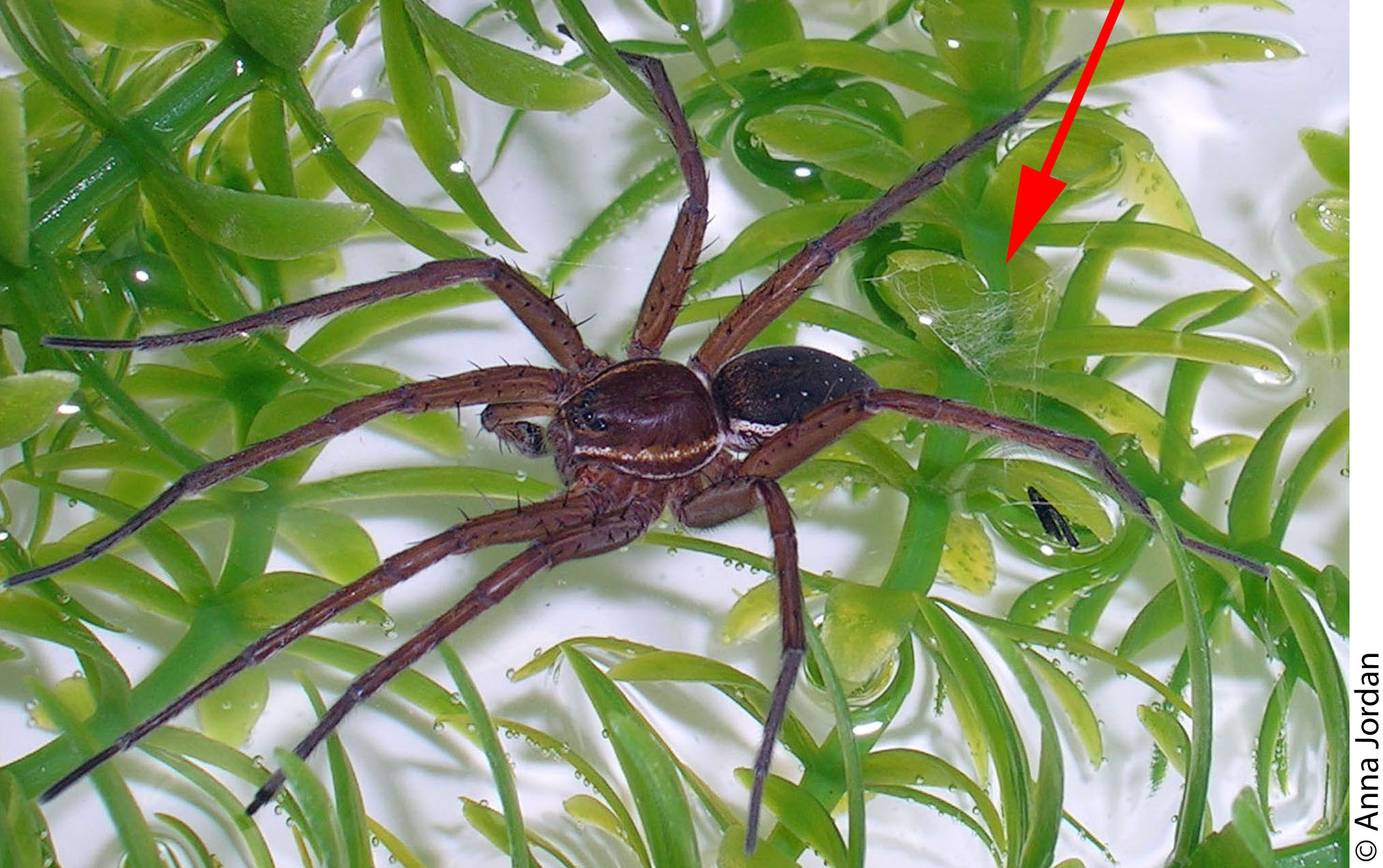
Throughout the courtship, the male stops frequently to groom his palps. In all spiders the palps are the intromittent organ. The end 'tarsal' segment of the palp becomes swollen in the immature males and after the final moult it is fully developed as a structurally complex secondary sexual organ. Much of the complex structure is internal but external projections - apophyses - also help to guide and facilitate the process of mating. Differences between these structures are often used to distinguish between closely related spider species; the detailed structure of one of them, the tibial apophysis, is the key feature used to distinguish male D. plantarius from D. fimbriatus (see Identification). Prior to courtship, the male secretes sperm from inconspicuous sperm ducts under his abdomen on to a tiny triangular 'sperm-web', before drawing it up into a reservoir in the palpal organ.
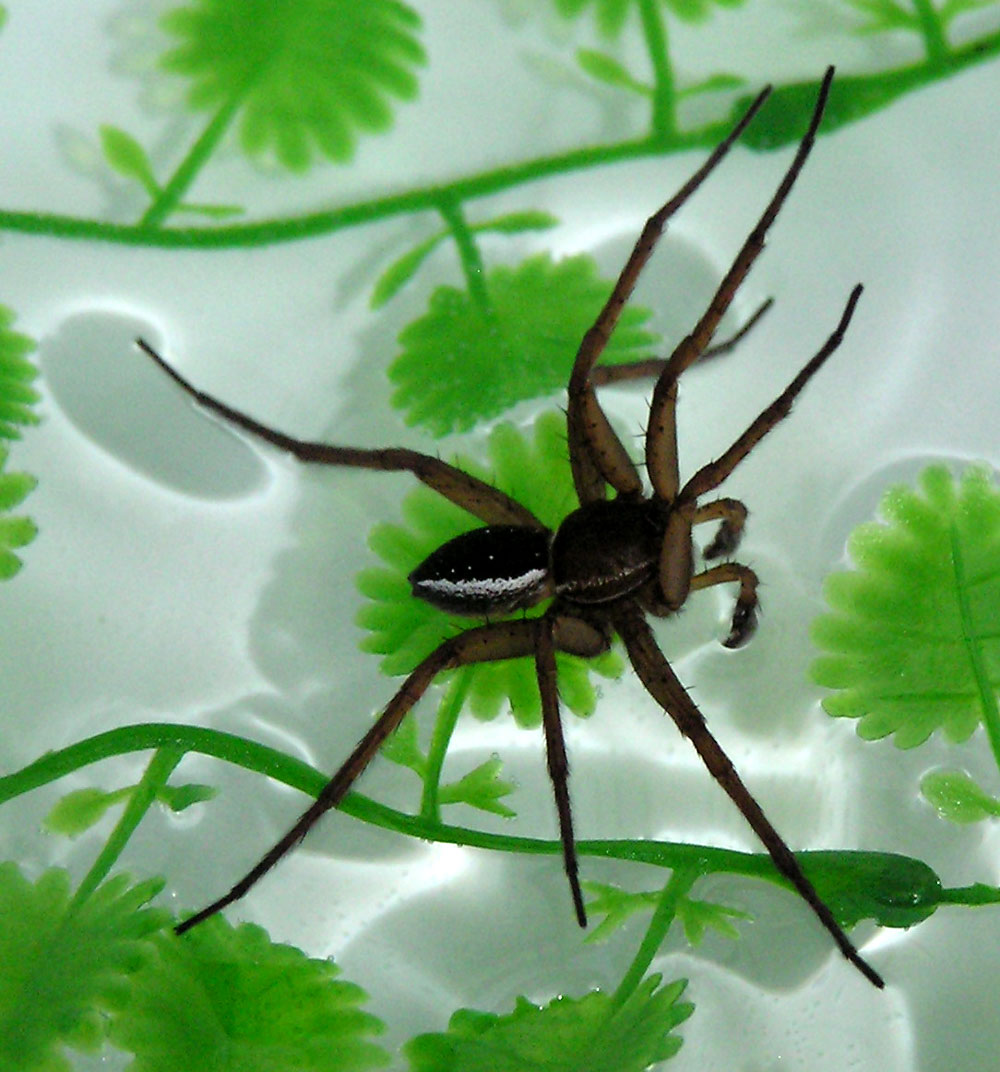
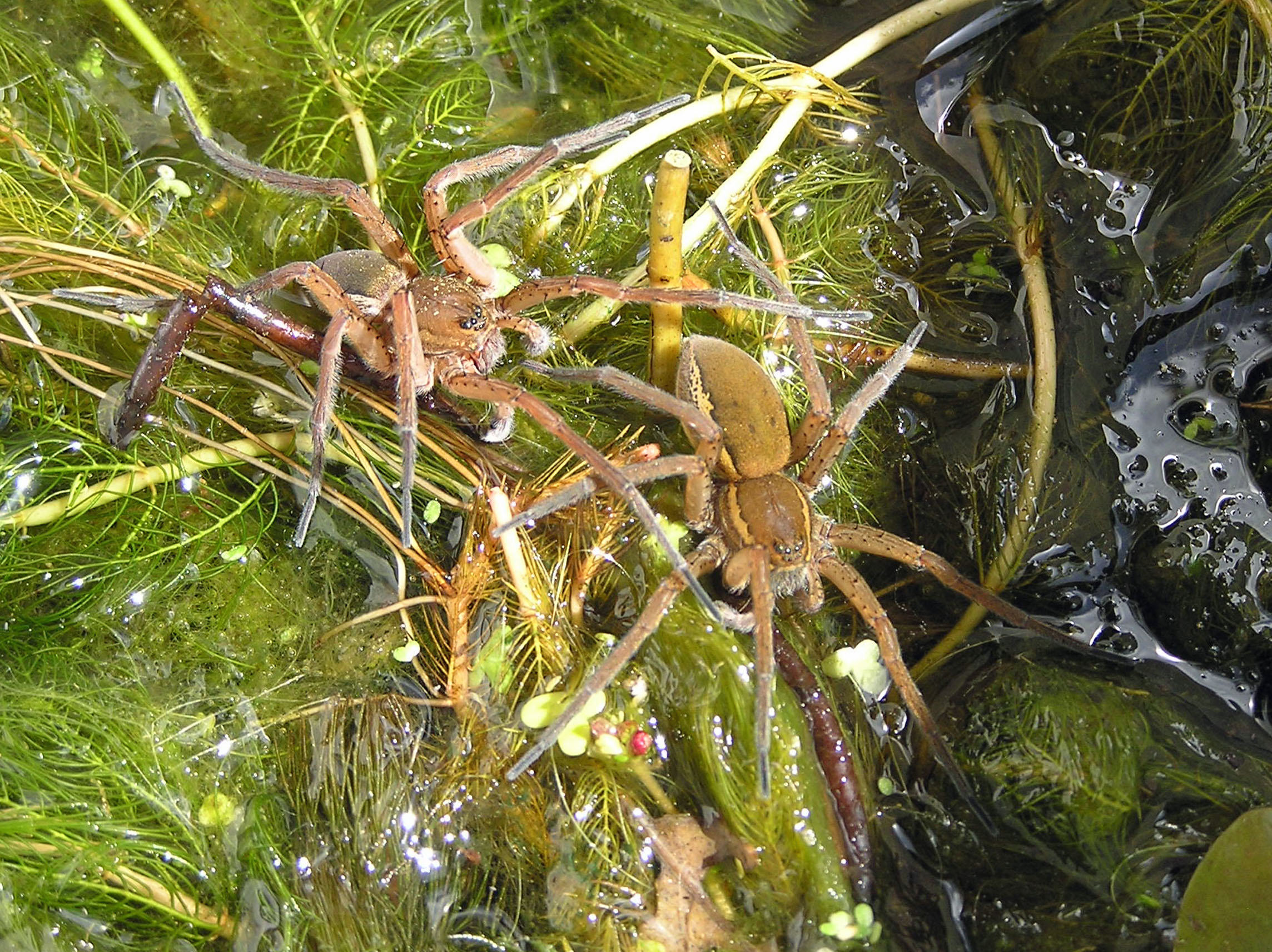
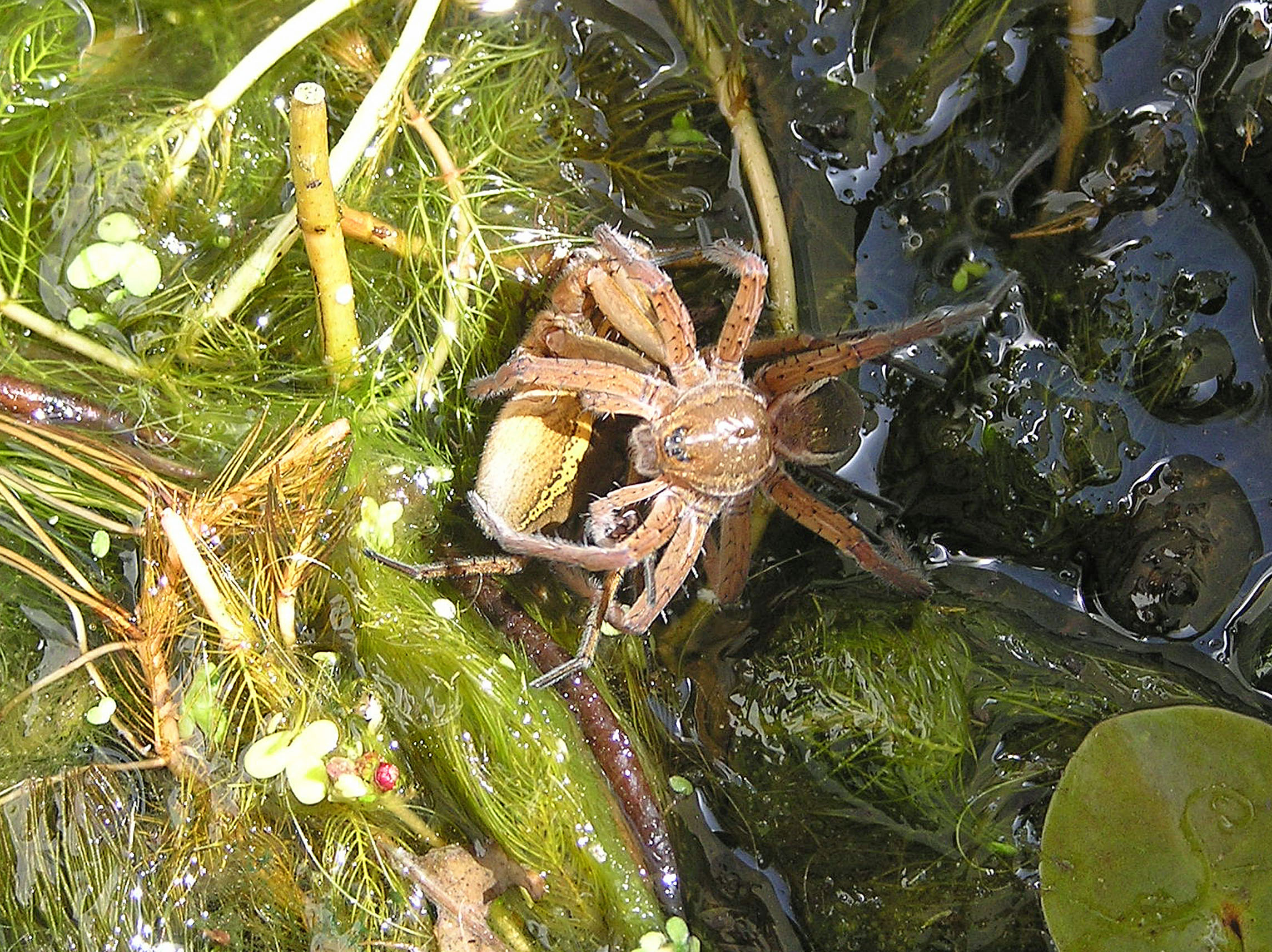
If receptive, the female usually allows the male's approach, sometimes after rebuffing him several times, signaled by high kicks of the front legs and agitated bobbing. In a successful approach, when the male and female are very close, they may both bob their bodies slowly up and down. The male usually flicks his front legs rapidly as he moves in to touch the female, vibrating his legs across her body. She pulls her legs tightly in against her body to allow the male to roll her over onto her back in the water. In this position the male can inseminate her, transferring sperm from one or both palps into her genital opening, the epigyne (see James Dunbar's video footage - below). If only one palp is discharged, the male will usually withdraw a short distance to groom his palps before approaching the female again for a second copulation. Inside the female, the sperm move via ducts to paired sacs, the spermathecae, where they are stored. The eggs are fertilised only later, as they are laid.
In 2012 James Dunbar, a student on the Salford University MA course in Wildlife Documentary Production, worked with Helen Smith to produce a unique insight into the normally secret lives of D. plantarius during their breeding season at Redgrave and Lopham Fen, East Anglia. Click here to watch James' film - NB University of Salford 2012 all rights reserved.
In captivity, mated females, particularly when very gravid, have been found to rebuff approaches by other courting males by aggressive flicking their front legs and by rushing towards them. However, there is evidence from DNA studies (Vugdelić 2006) and from brood analysis (Baillie et al. 2019) that multiple paternity occurs in at least 16% of broods in the wild. Matings with females that have completed their first broods have not been observed in the wild, although males have frequently been seen courting females with broods still in the nurseries (see below) and it seems likely that some of these are successful. As the breeding season progresses, male numbers drop rapidly. The majority of second broods is almost certainly fertilised with stored sperm. The latest British record of a courting male is from 5th September (in East Anglia), but this is a very exceptional observation.
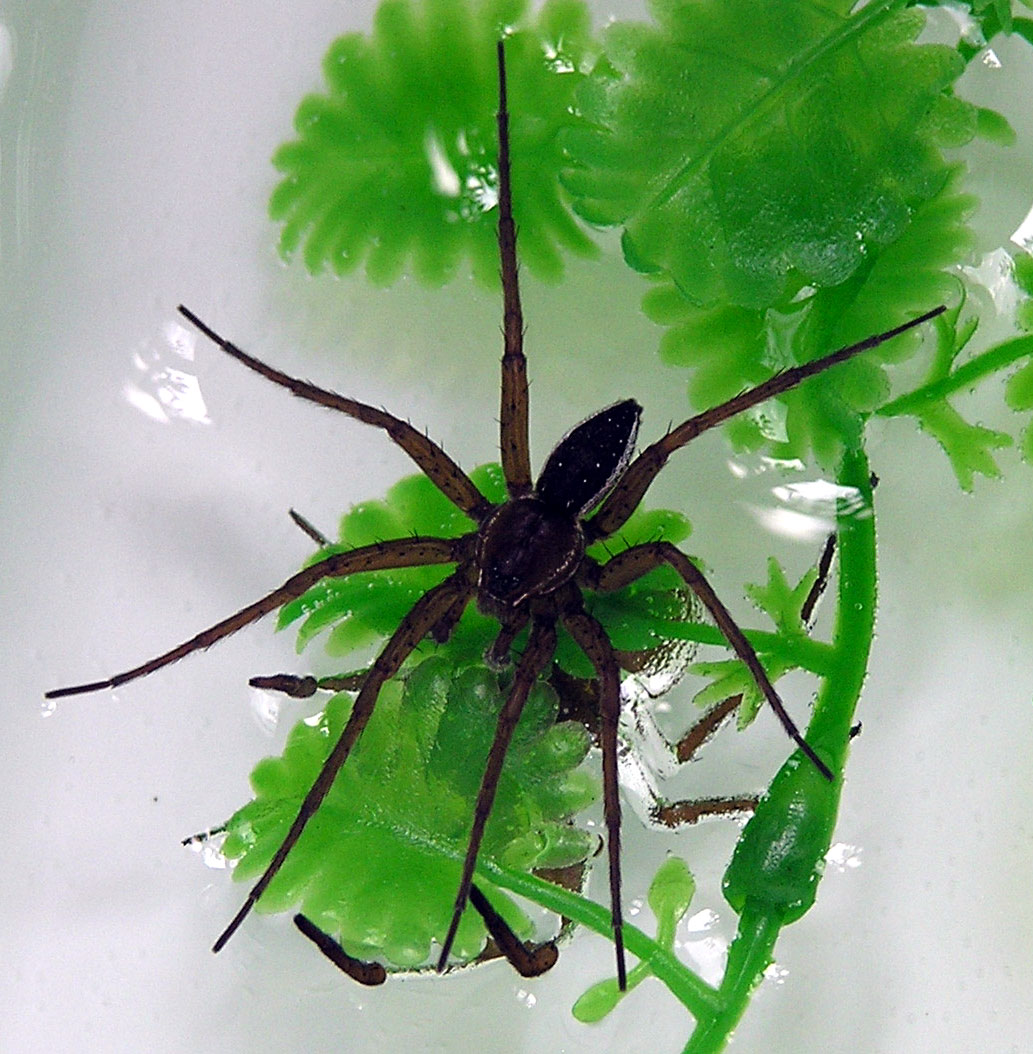
The males will also guard sub-adult females even though they cannot mate with them: the females do not develop an opening to their reproductive tract until after their final moult. In captivity, an immature female has been recorded hiding from a courting male by remaining underwater for a protracted period. Male guarding of immature females is not uncommon across a wide range of spider species. It gives the male priority when the female matures. In D. plantarius, a male has been observed mating with a very recently moulted female before her new cuticle had hardened. This mating took place at her moulting site, away from the water surface.
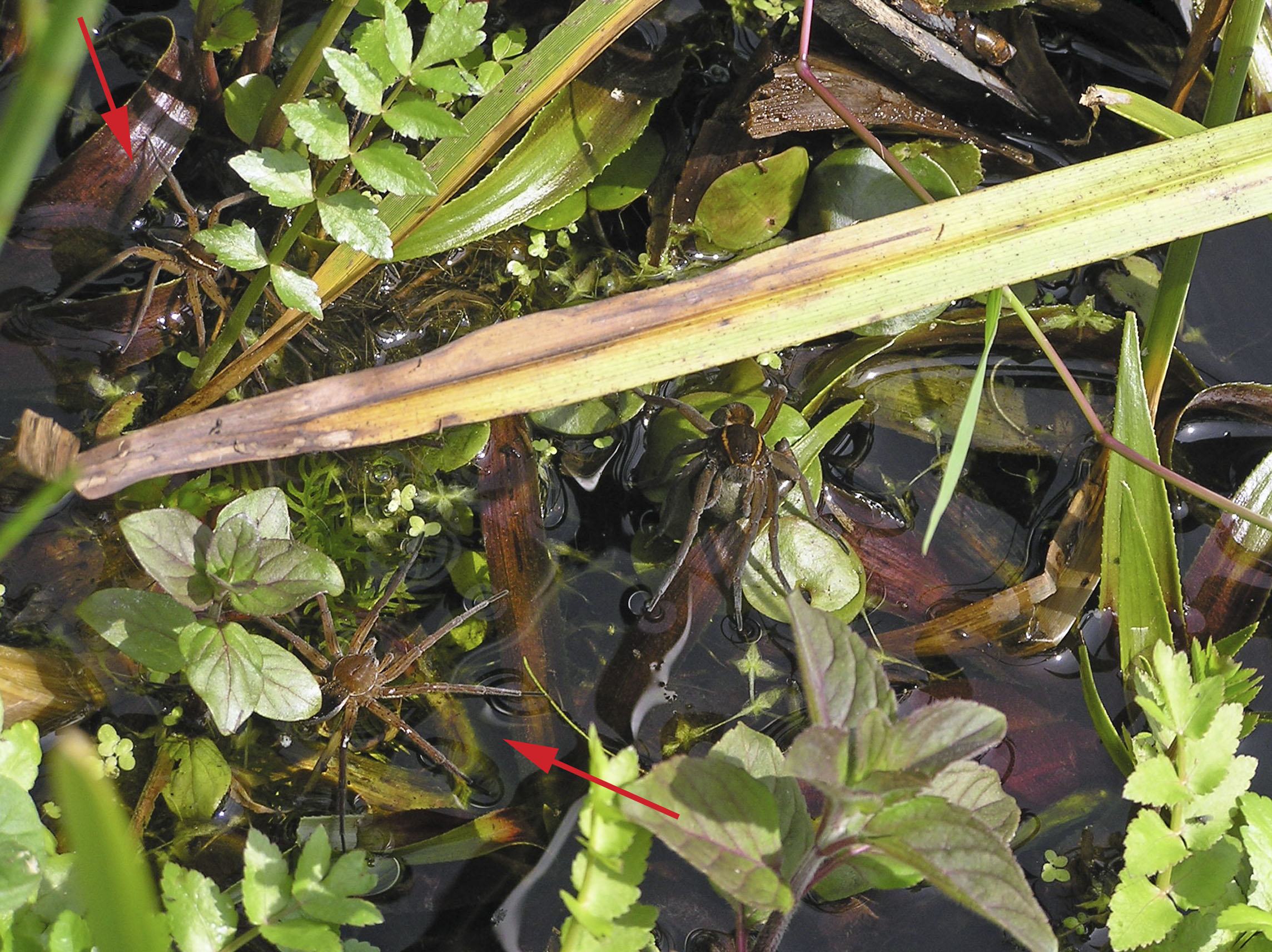
Males are also attracted to court females that are already carrying egg sacs and are unreceptive (see Neil Phillips' video footage). One has even been observed persistently courting a recently dead female.
Eggs and egg sacs
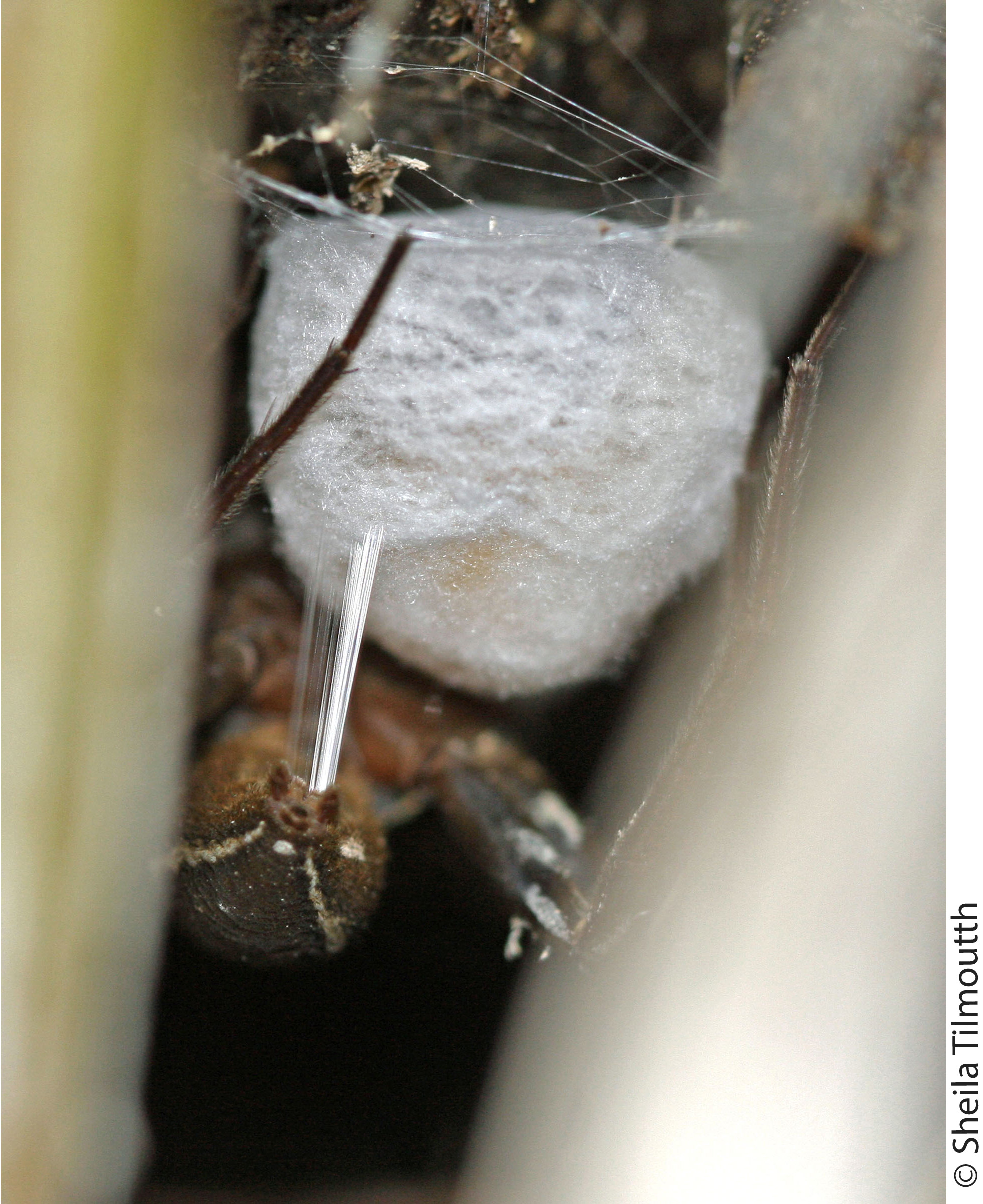
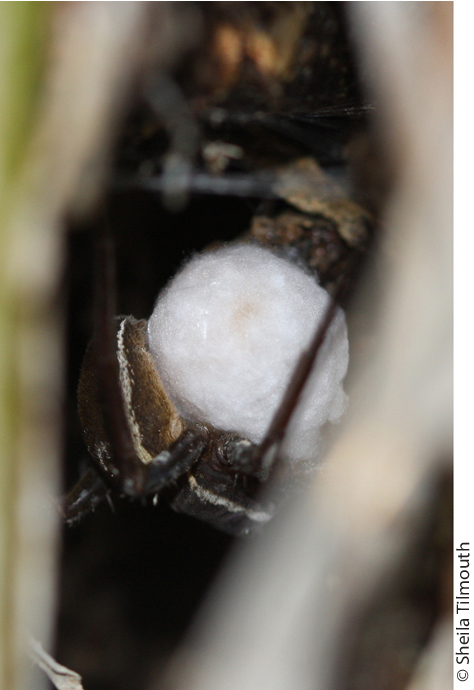
Proximity to water is vital to survival of the eggs once they are laid. The females lay their eggs into a large silk sac. They spin this as an inverted cup, anchored to vegetation. The female pivots, upside-down, in circle beneath the growing cup, streaming silk upwards around its rim. The yellow eggs are laid upwards into the cup which is then sealed with more silk before the anchoring threads are cut. A final layer of silk is then added by the female as she turns the ball round and round with her feet. The silk of the freshly spun sac is brilliant white and crinkled but the silk is used for the final, encasing layer is of a different type, with much straighter strands. On contact with the water, the white silk quickly turns grey as it oxidises. The female is clearly very vulnerable to predators immediately prior to, and during, construction of the silk sac and egg laying. In captivity this a nocturnal or crepuscular activity. In the wild, the sacs are spun in dark spaces deep in among damp vegetation, close to the water.
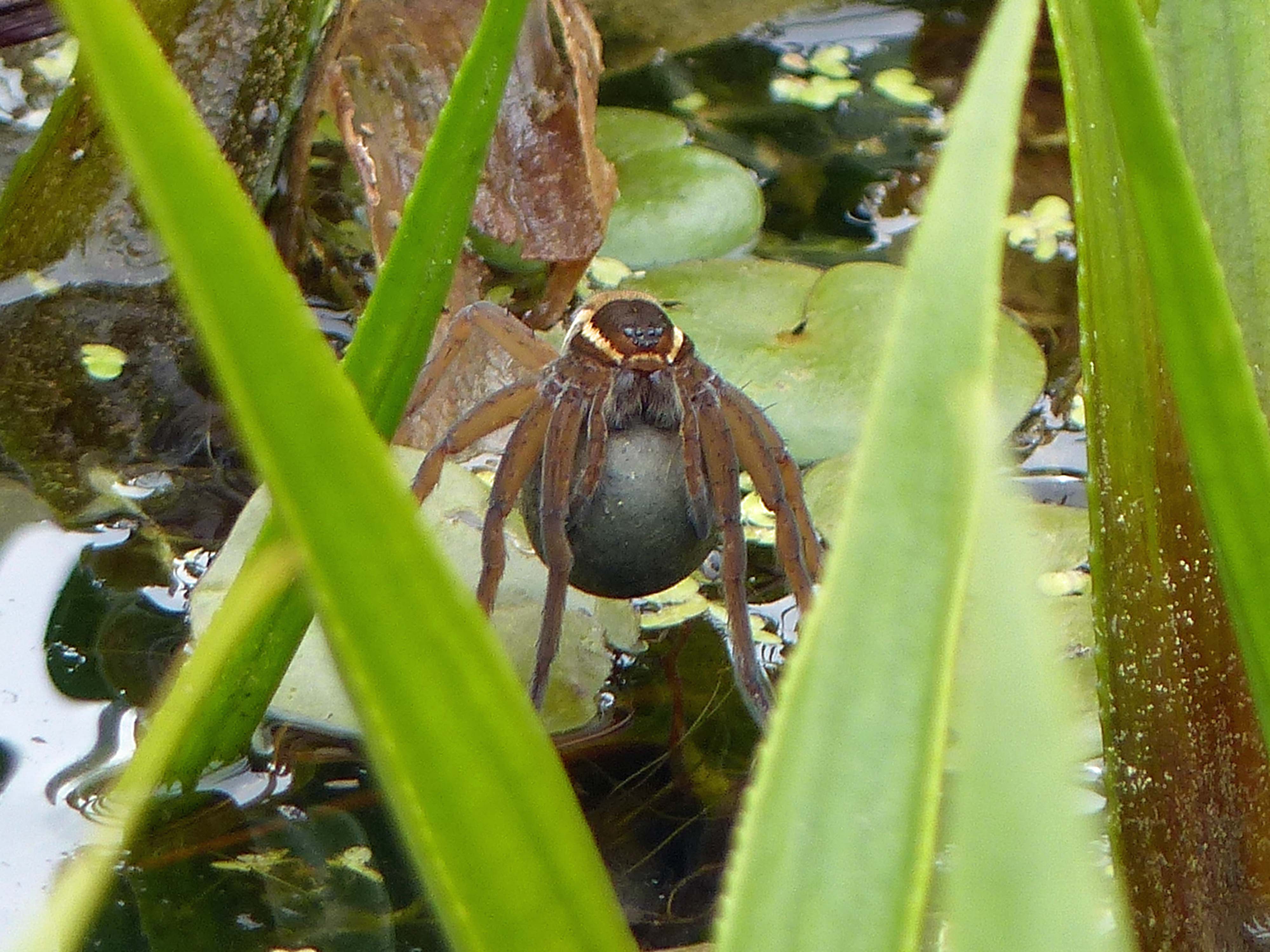
The female carries her egg sac under her body for three to four weeks, holding it firmly in her chelicerae, with her abdomen curled round it, usually with an additional silk attachment to her spinners. She puts her sac down only when she needs to groom - an essential activity for maintaining her waterproofing. Even then she will almost always remain in physical contact with the sac, with a leg wrapped over it, ready to grasp it again at the slightest sign of danger. The females rarely feed during this period. In captivity, only a small proportion of females offered food will put their egg sacs down and eat. In the wild, there are very few records of females with eggs sacs taking food. Particularly in dry weather, the female must push her egg sac under the water surface every few hours to keep the eggs moist. In the absence of water the first the eggs, and later the young, which hatch whilst still encased in the sac, desiccate and die (Bonnet 1930).
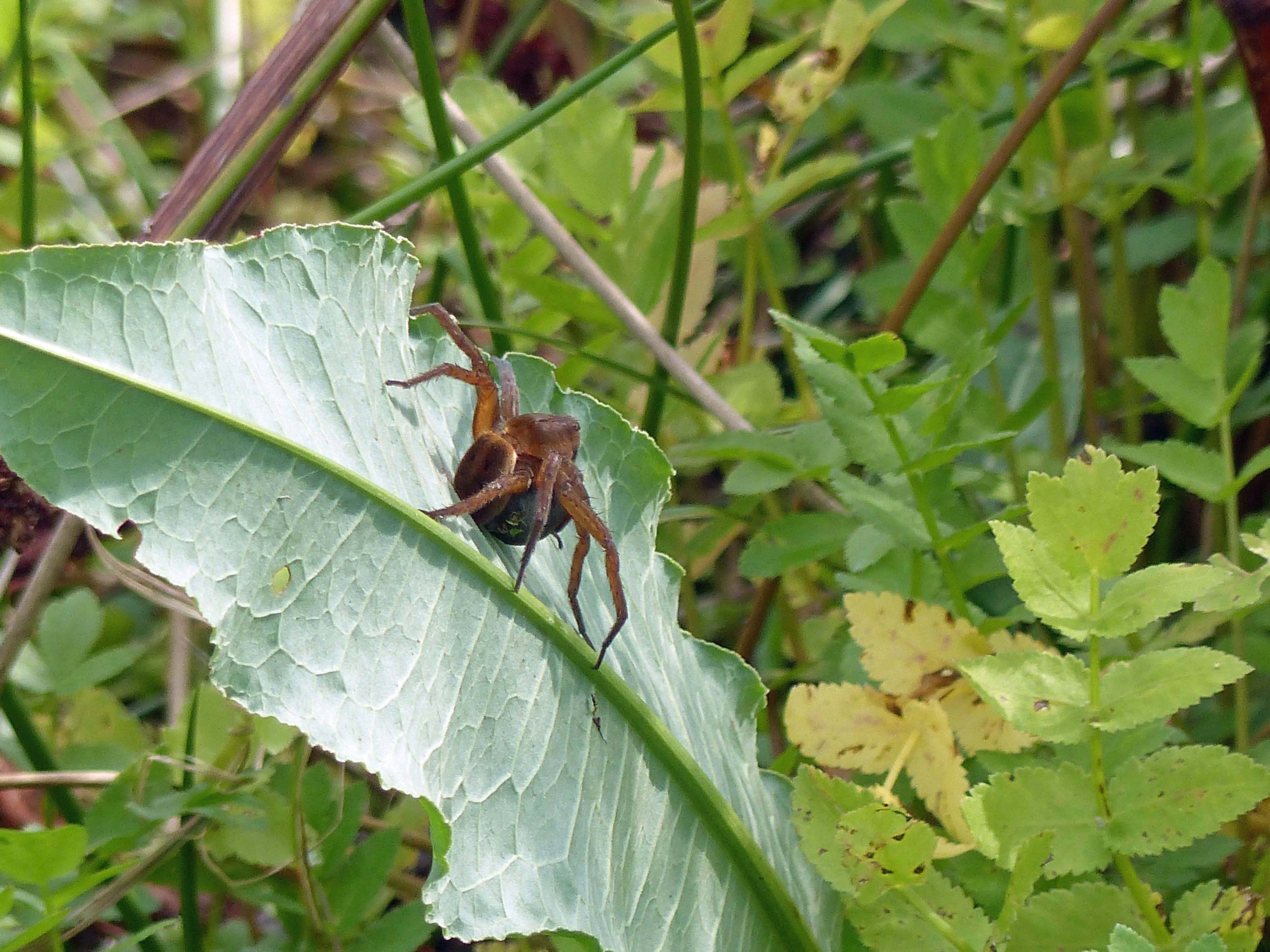
The young spiders undergo their first moult whilst still within the egg sac. As the time approaches for them to emerge, their mother spends increasing amounts of time sitting in emergent vegetation at the location where her nursery web will eventually be constructed, up to a metre above the water. Holding their large egg sacs in these relatively exposed locations, females appear to be very vulnerable to predation, but are able to drop suddenly into the water if disturbed.
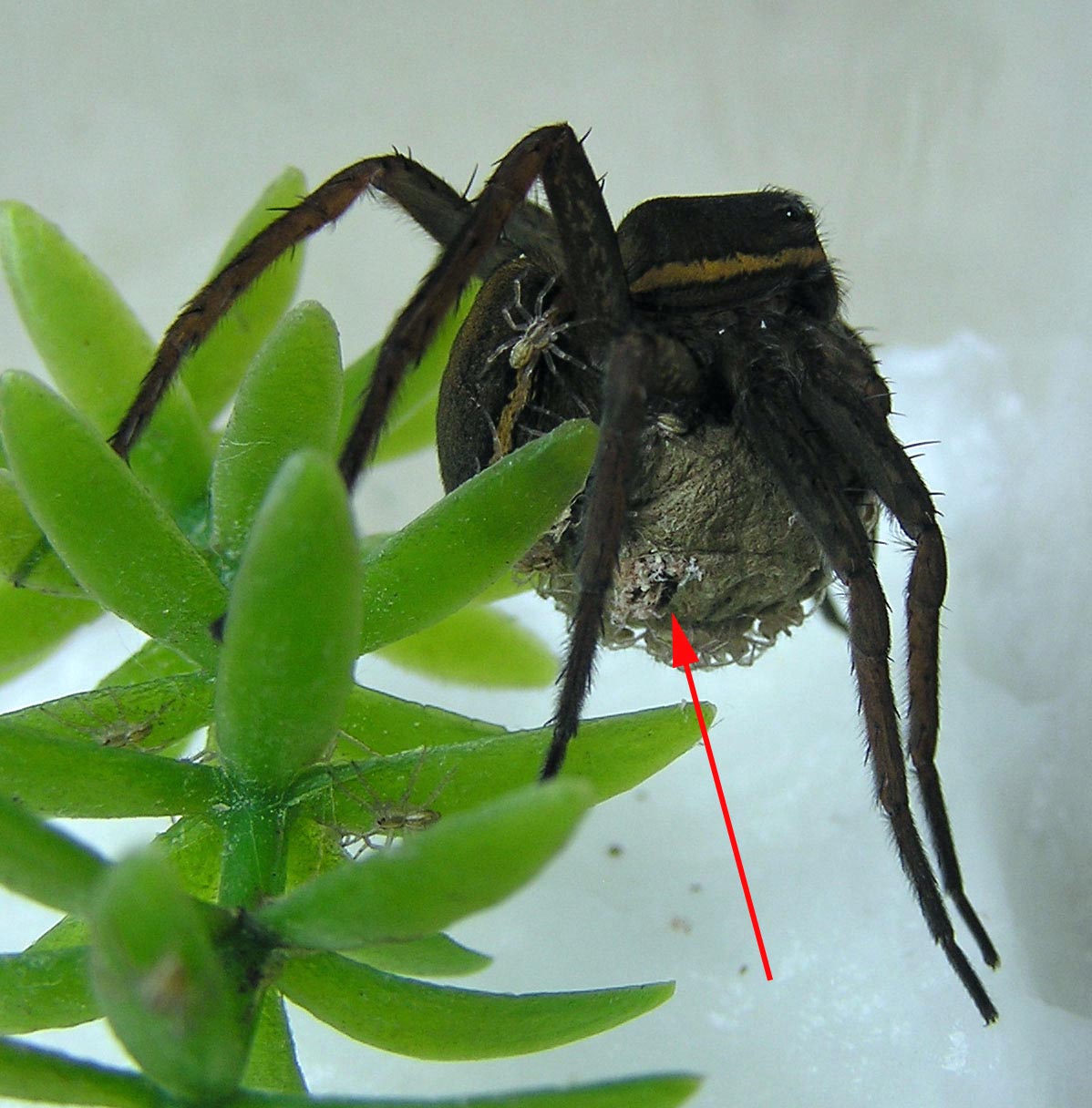
Once the spiderlings hatch within the sac, it changes from its initially smooth grey appearance to an increasingly soft and saggy brown bag. The mother assists the spiderlings' eventual emergence. During the night, about 24 hours before emergence, she turns the sac with her legs, biting through the tough silk. By morning& holes though which the young can eventually emerge are clearly visible. Although a few young may emerge during the day most do so in the early hours of morning, before dawn. Captive females have also been observed stopping to tear at their sac with their chelicerae while spinning the framework of the nursery (below), allowing bulk emergence of the spiderlings. It is not know whether the spiderlings assist with their own escape by biting through the silk on the inside of the sac.
Nurseries
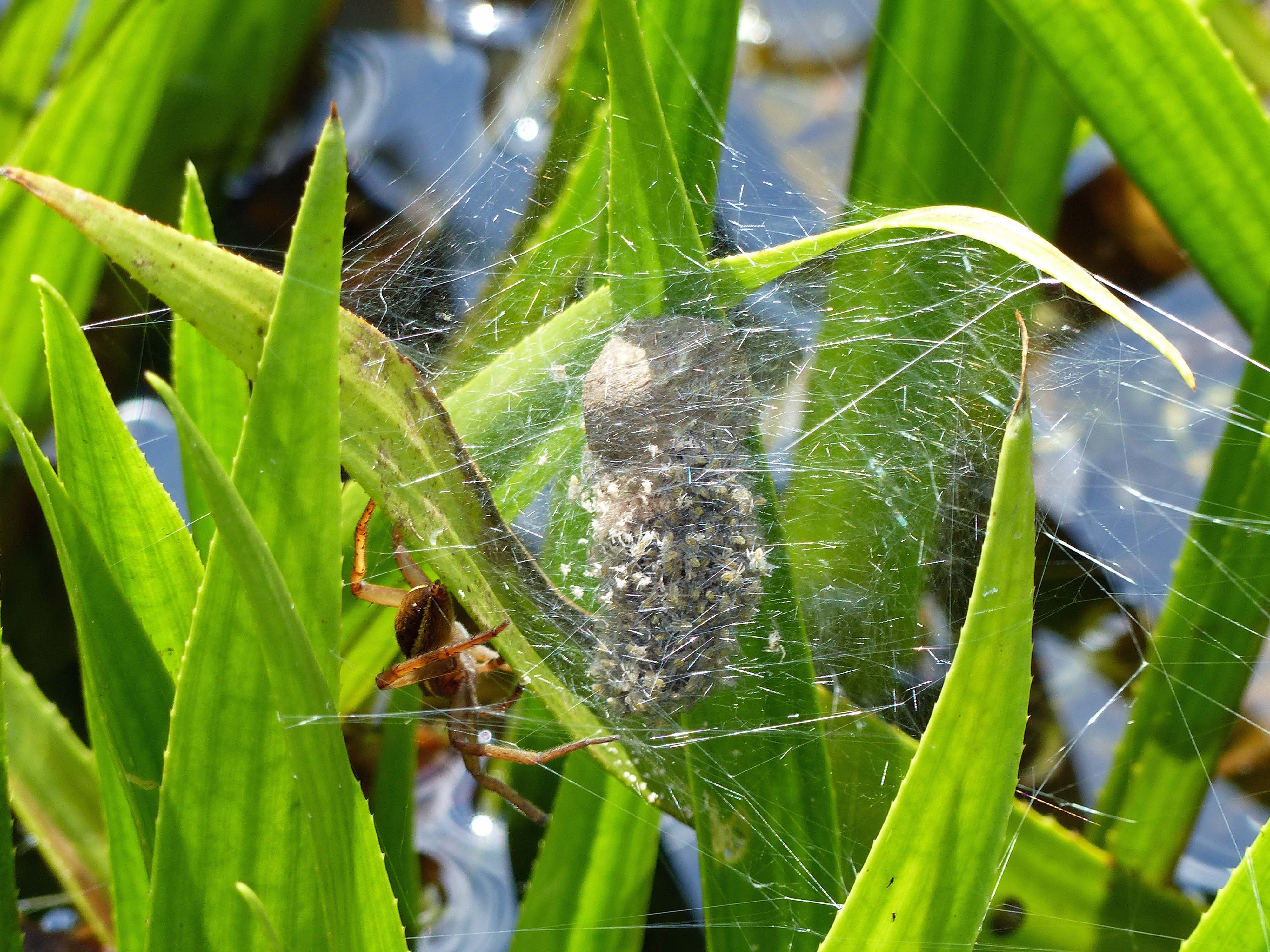
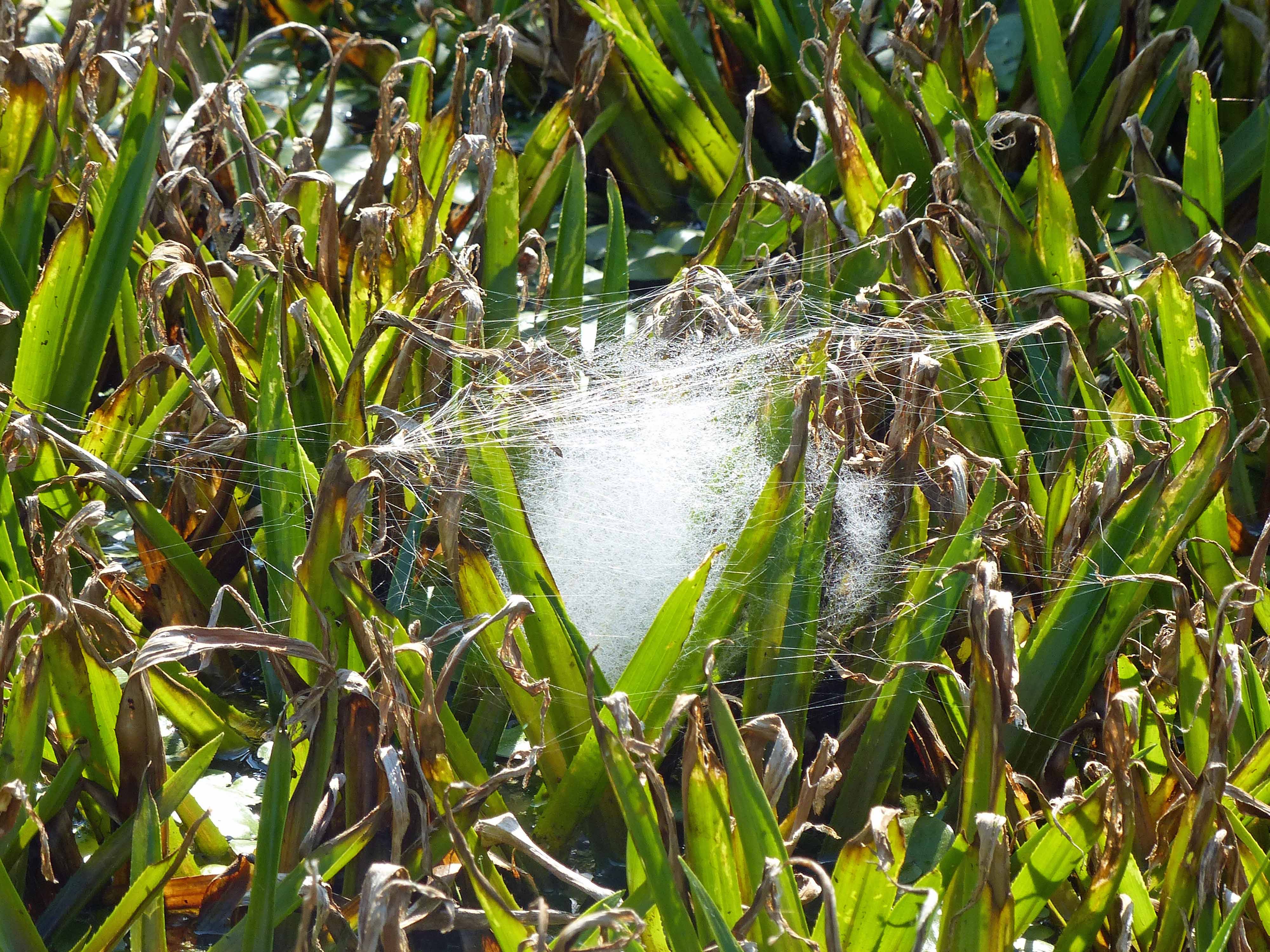
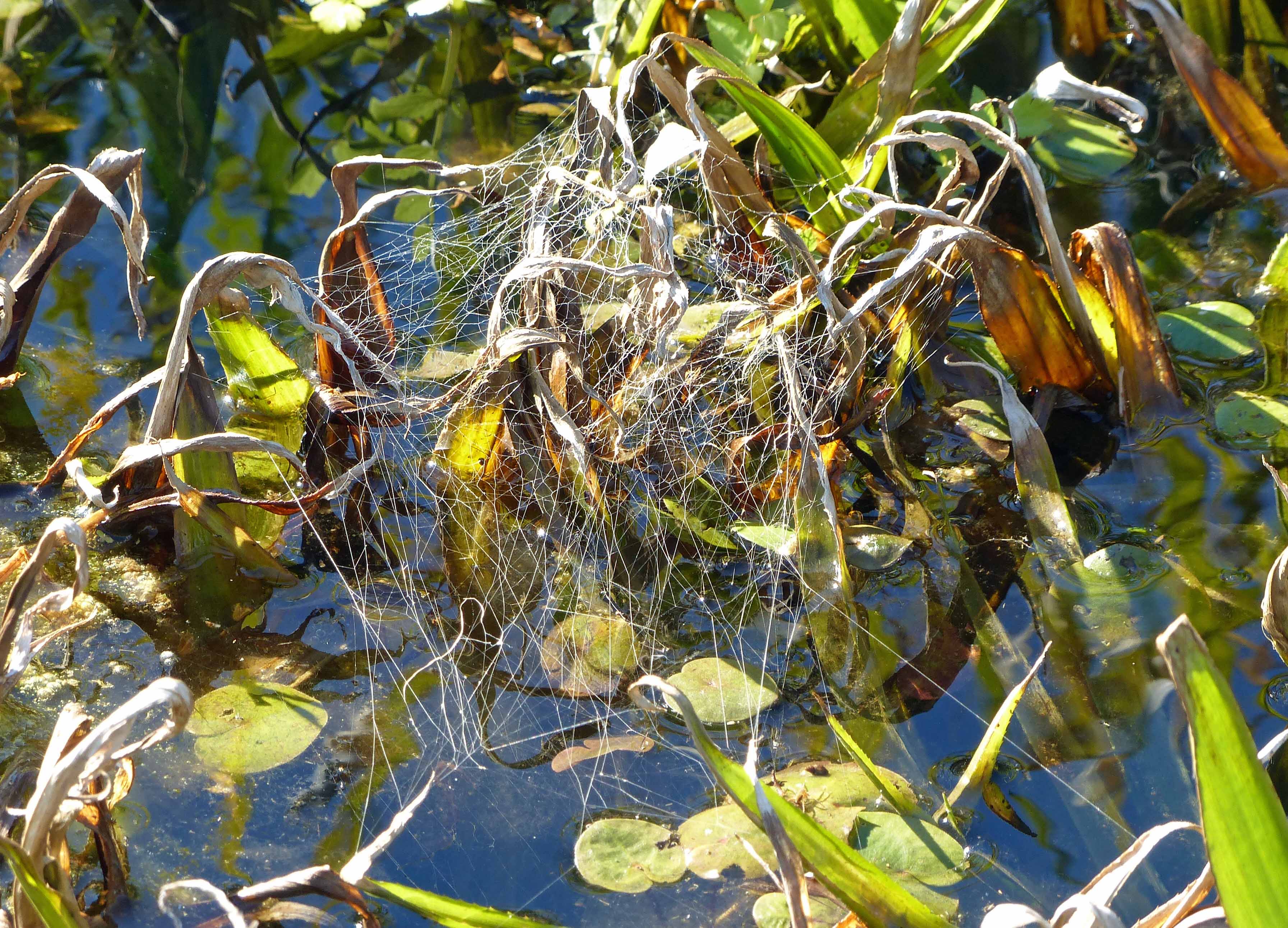
The spiders of the family Pisauridae, including D. plantarius, are also known as nursery web spiders because they guard their young in large, tent-like silk nurseries. These are usually built at night but females are occasionally seen still adding to the structure of new nurseries the following morning. The nurseries of D. plantariusare attached by many long, silk anchors to emergent vegetation, usually between 10 and 100 cm above the water. In captivity the mother constructs the basic framework of the web. However, much of the dense internal structure appears to be contributed by the activity of the spiderlings, dragging silk lines behind them. The tendency of nursery webs to hold dew shows up their increasing density during the period the spiderlings remain in residence. The web starts gradually to break down about 24 h after the spiderlings disperse. Nurseries vary greatly in size and shape, with the anchoring threads spanning substantially greater distances than the dense core of the structure. Very small nurseries become more common towards the end of the season.
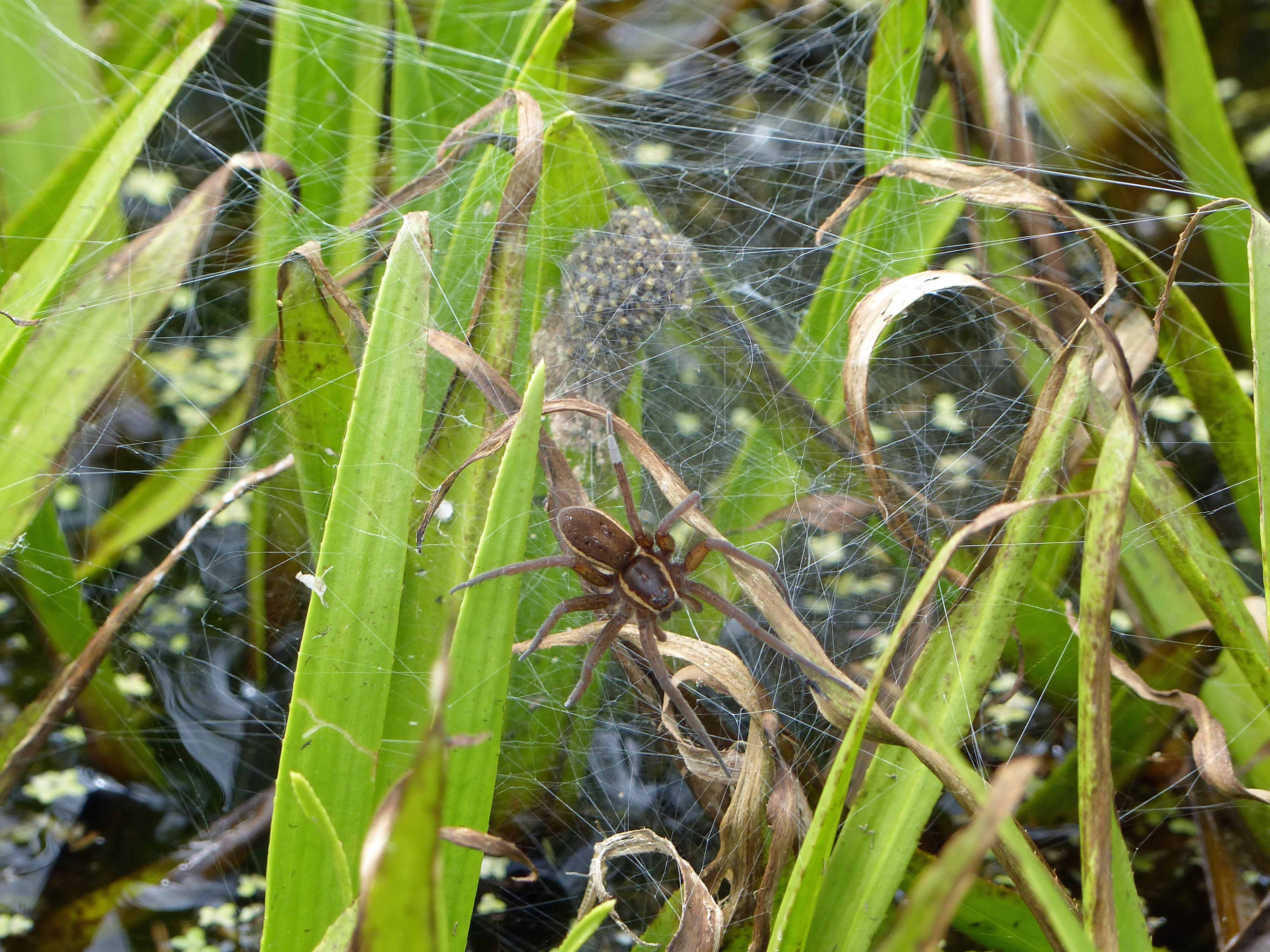
The mother usually sits close to the nursery structure, often in contact with the anchoring threads and sometimes very conspicuously on the exterior of the tent. Some mothers are very active in the defense of their nursery and will rush out and attack anything that threatens the integrity of the web. However, this does not seem to be universally applicable. Particularly for first brood mothers, the need to resume feeding after their long fast may, at times, take priority over defense of the nursery. Second brood (see Phenology below) mothers are much more likely to be seen sitting in a conspicuous position on the nursery.
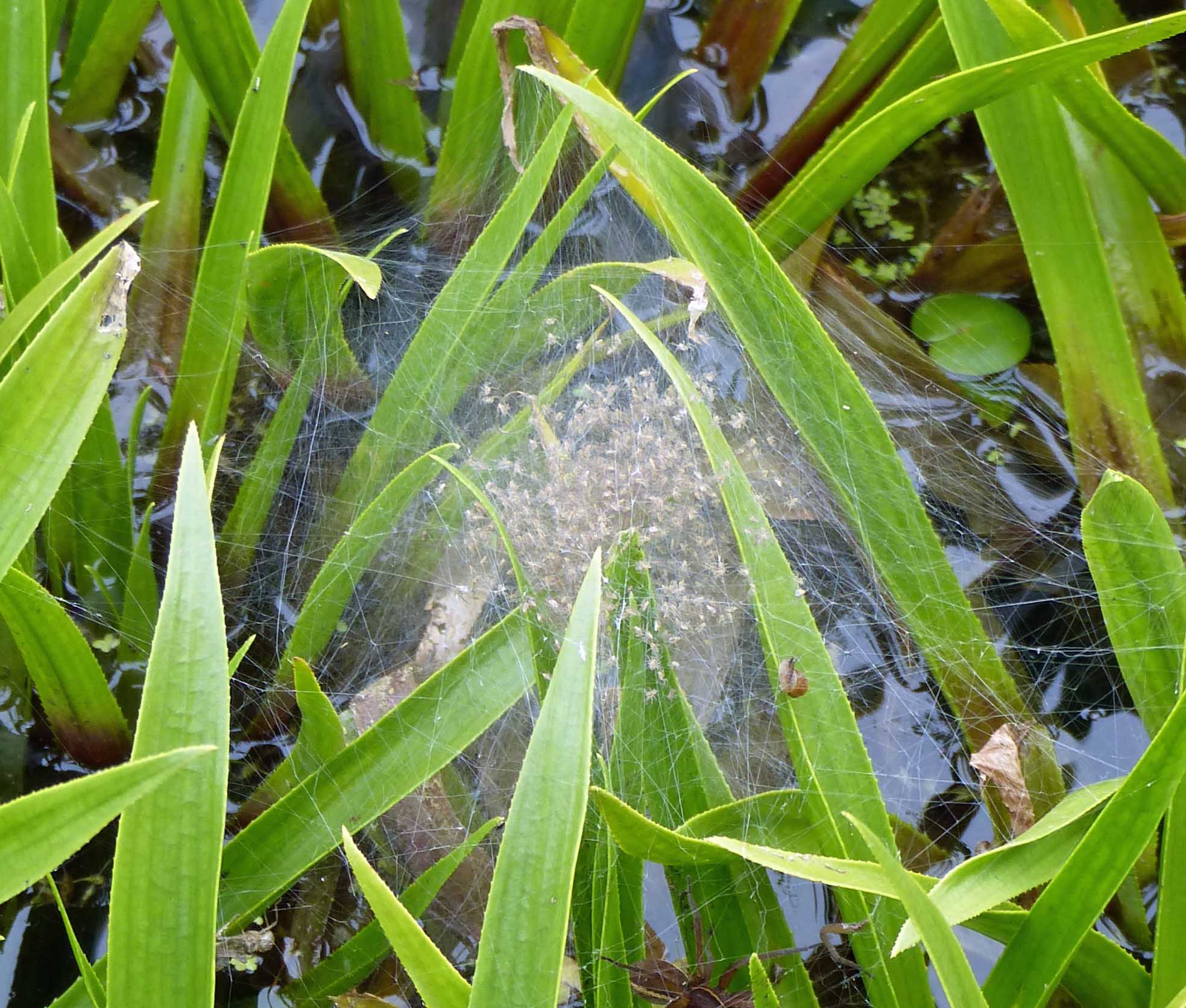
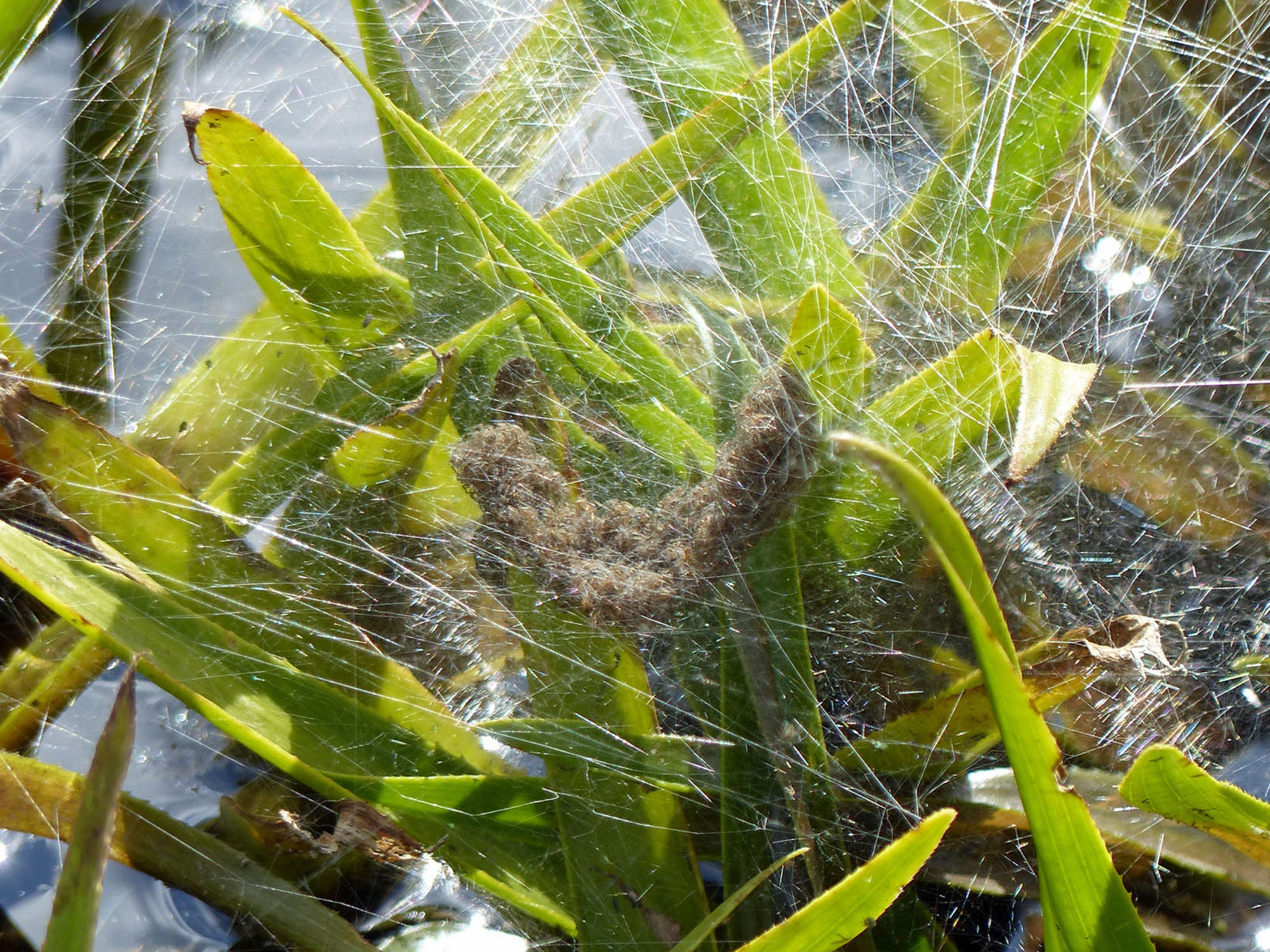
At dusk the spiderlings become active, dispersing from the balls throughout the nursery. By day, they cluster tightly into a dark ball which can be seen along with the torn remains of the silk egg sac. Below the tear, the skins moulted by the spiderlings within the sac, and dragged from it as they emerge, are usually visible as a trail of tiny white dots. In bright sunlight, the balls of spiderlings often flatten forming to form a concave lens shape. Any vibration of the web that alerts the spiderlings to danger results in them 'exploding' from the ball to disperse down the anchoring silk lines, only to regroup when the danger is past. This response occurs if any of the nursery's silk anchor lines are touched, but it can also result from more remote dangers. Simultaneous explosion of the spiderlings balls in all of the nurseries within a densely populated water body has been observed in response to a heavy train passing near-by and causing vibration through the substrate.
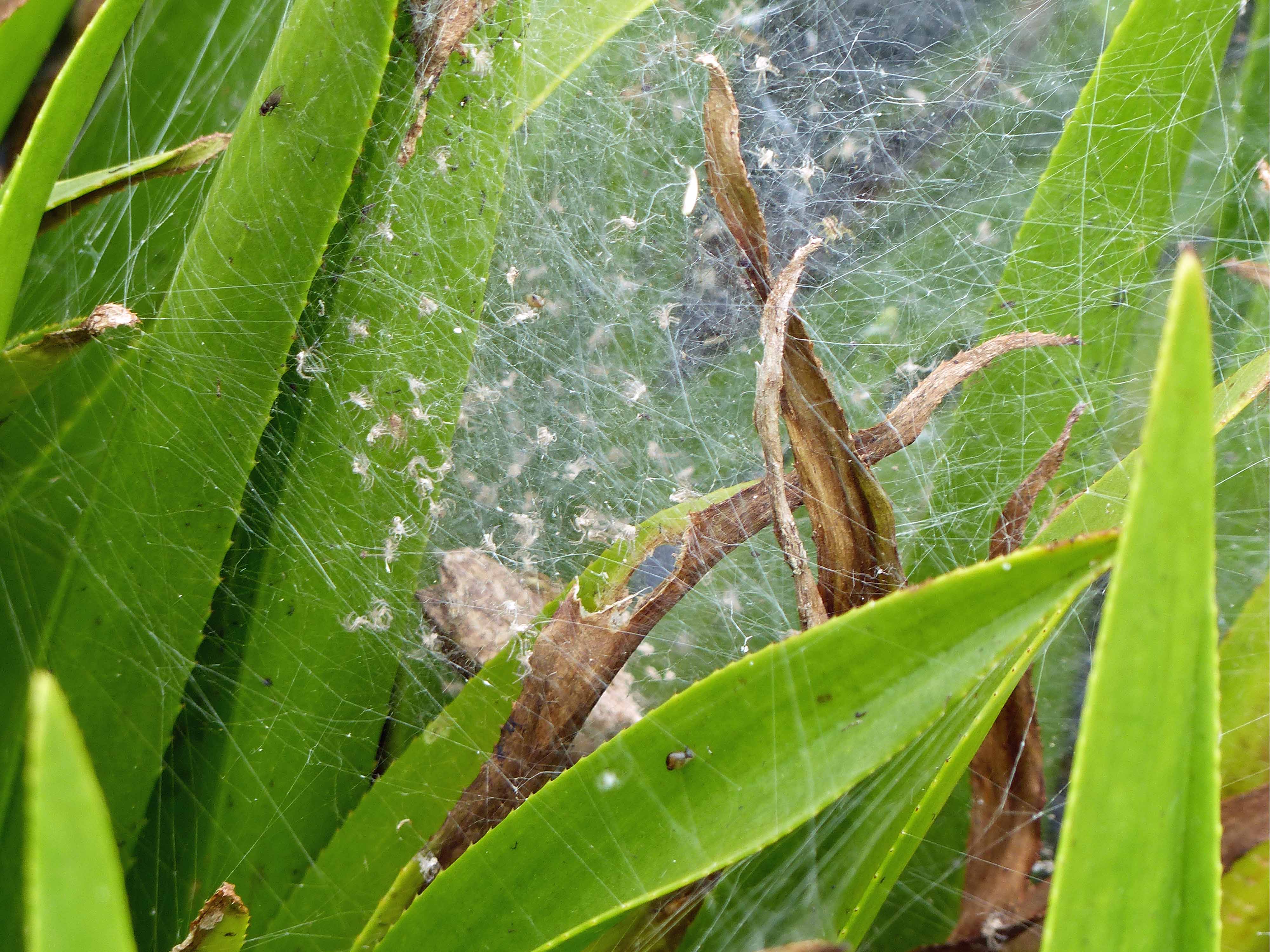
Dolomedes plantarius spiderlings usually remain in the nursery for between five days and a week before they disperse to begin an independent life. There is some evidence that residency time in the nursery increases towards the end of the season. Very rarely, in the wild, nurseries are found that contain moulted skins of spiderlings that have clearly dispersed much later than average. In captivity, if left in the nursery in a confined space from more than about 10 days, some spiderlings start to exhibit cannibalism.
Spiderling dispersal
Despite very many daytime hours of observation of nurseries, there are no recorded observations of D. plantarius spiderlings actively dispersing from nurseries in the wild; this appears either to be a largely nocturnal process. High concentrations of spiderlings are found in the vicinity of recently deserted nursery webs suggesting that many of them leave the nursery and move out into the immediately surrounding damp vegetation. The spiderlings also have the potential to disperse by so-called ballooning - the process by which small spiders release silk lines that catch in the breeze, lifting them into the air like a kite. However, although D. plantarius spiderlings can exhibit ballooning behaviour - moving upwards through the vegetation above the nursery, standing on tiptoe and releasing silk lines in gentle breezes, they usually wait until their silk lines catch in near-by vegetation and then move along them (so-called 'rigging'). When captive nurseries with dispersal-stage spiderlings were removed into the wild as part of the translocation programme for this species, the spiderlings were seen streaming upwards to the highest accessible points of the surrounding vegetation. Most then rigged across to nearby vegetation, although some exhibited ballooning and traveled distances of 10 m or more (see also Locomotion).
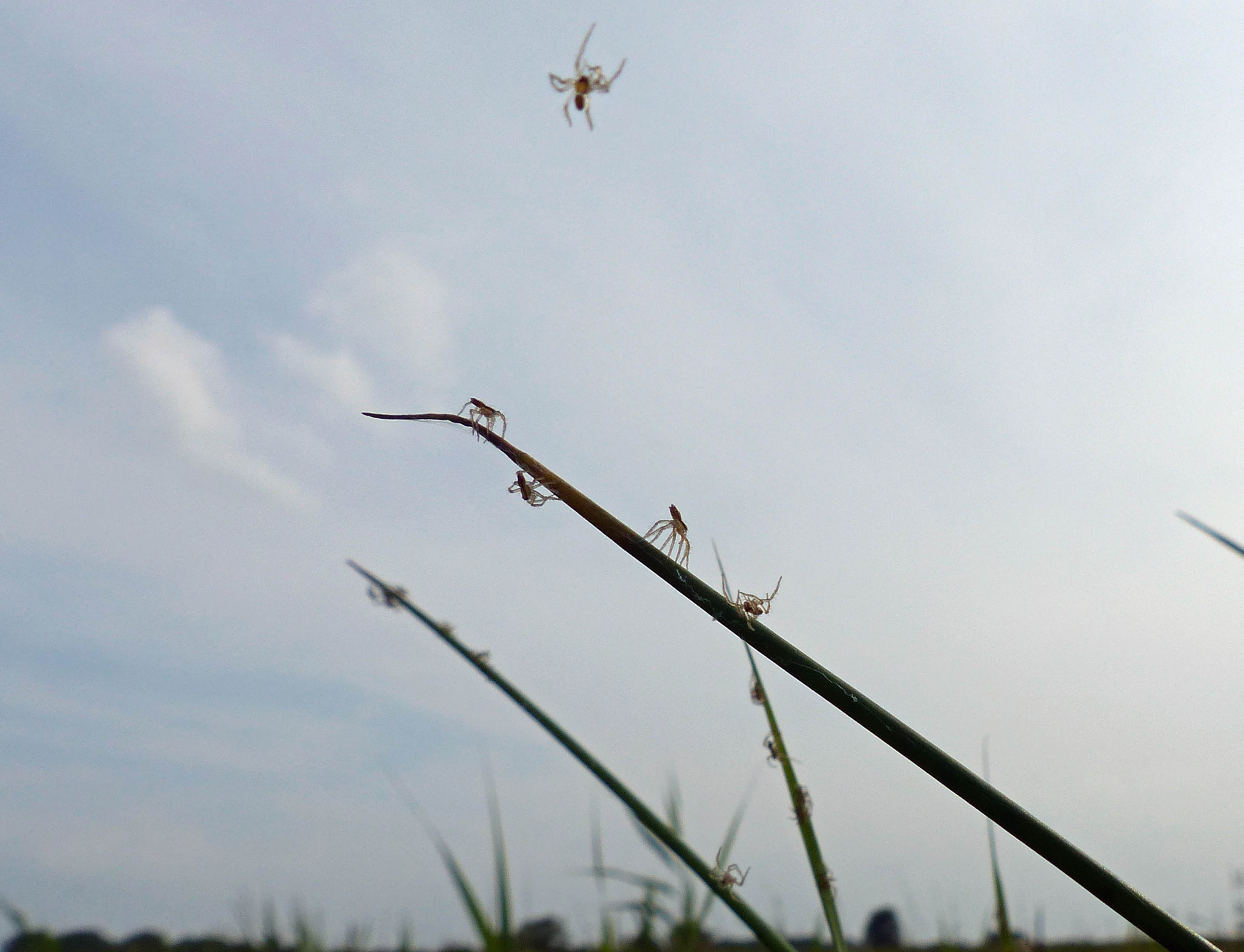
Under experimental conditions, spiderlings of the rather commoner D. fimbriatus have a greater tendency to balloon than those of D. plantarius at a similar age (Pearson 2008) and, in the field, its spiderlings are frequently recorded in trees. A reduced tendency to balloon in D. plantarius may represent an adaptation to living in small, isolated patches of habitat. Ballooning spiders have no control over where they land and, when suitable habitat is in very short supply, there is likely to be heavy selection against individuals dispersing by this means.
The tiny D. plantarius spiderlings rarely re-appear on the water surface until they are 3-4 mm long and several months old. If blown onto a water surface, or if the surface is disturbed by the wind, they can drown by 'sticking' to the meniscus. At this stage they are thought to live and hunt largely in damp vegetation.
Phenology
At Redgrave and Lopham Fen National Nature Reserve, East Anglia, D. plantarius usually take two years to mature, becoming adult, breeding and dying two years after hatching. However, there is increasing evidence that the life span can be quite variable; from one to three years. Most of the spiders undergo their final moult and emerge as adults in late April or May. Courtship begins immediately. Females swollen with eggs are in evidence from late May onwards. They can usually be seen carrying sacs from early June, with the first nurseries appearing towards the end of the month.
Although the great majority of adult male D. plantarius mature in spring in Britain, a single observation of a newly matured male on 9 October 2015, in East Anglia, shows that there is some plasticity in this trait. Males mature, on average, slightly earlier than females but are rarely found in the wild after the end of July. Once adult, they feed infrequently and travel relatively long distances (e.g. Pearson 2008) in their single-minded pursuit of females. Starvation and exhaustion is very much more common cause of death than cannibalism by females during courtship. Even in captivity, although cannibalism has been observed occasionally, it is extremely rare.
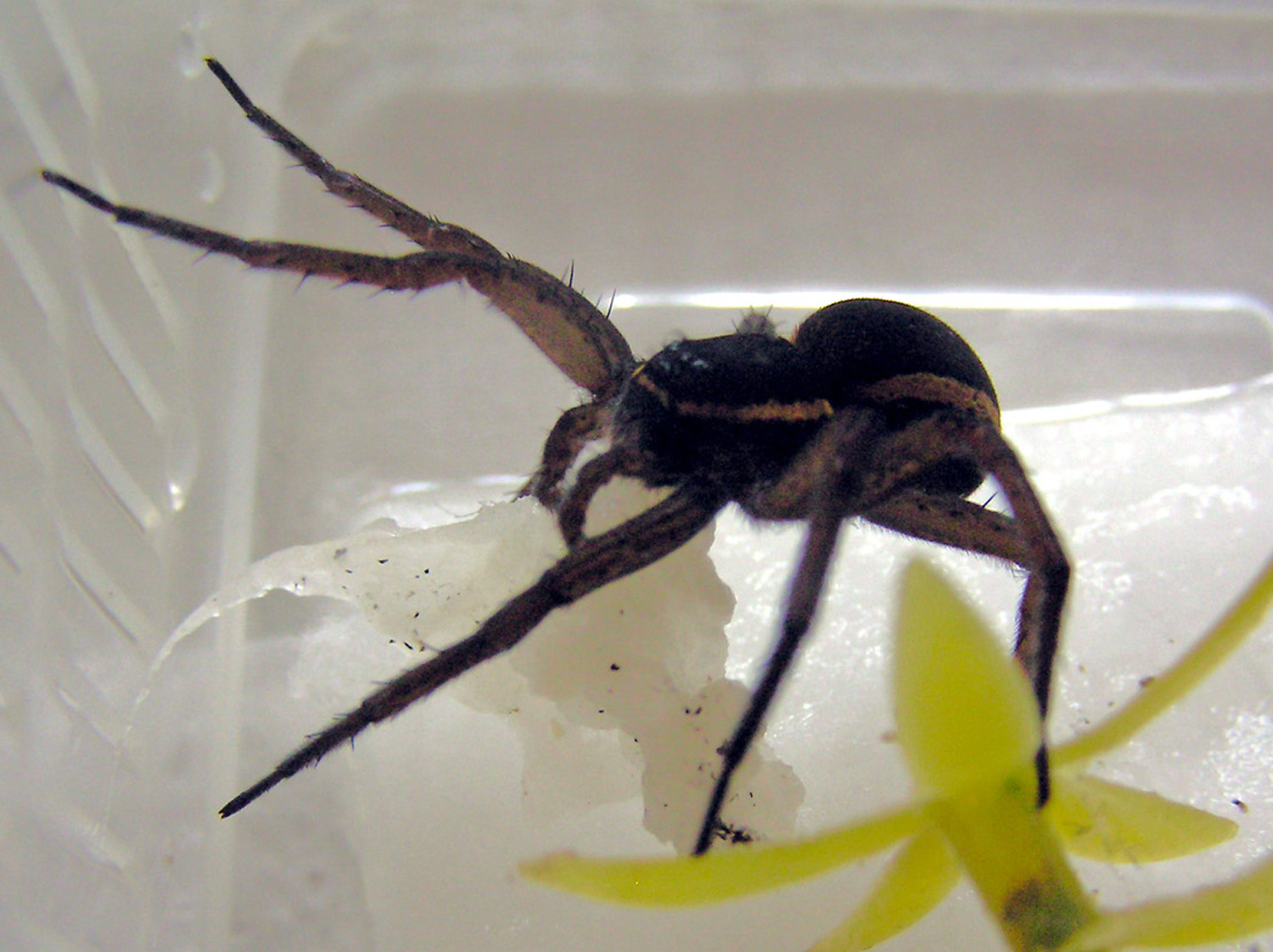
Adult females can survive until autumn. Although most nursery web building is concentrated in July and August, the breeding season is protracted. In the wild, most adult females are thought to make two breeding attempts during the summer in Britain and there is some evidence that a small minority of females produce three egg sacs. One individually marked female on the south coast of Britain produced three fertile egg sacs, while the phenology of egg sac production through the season suggests strongly that third broods are produced by a significant minority of spiders in very favourable breeding seasons (see New Populations). In captivity, female D. plantarius normally produce three eggs sacs and some go on to produce a fourth. By this stage though, the sacs are small and the eggs infertile, presumably because the store of sperm is exhausted. Unmated females also produce egg sacs but these are usually smaller and oddly shaped compared with sacs containing fertilized eggs. The mother nevertheless displays strong maternal behaviour towards them, carrying them for longer than the normal three to four week term. If she puts the sac down, she may inadvertently pick up and carry another object. In captivity this has included cotton wool and even, in one case, a finger tip! Virginal egg sacs are very rarely seen in the wild but have been encountered in some years in the very small, natural population at Redgrave and Lopham Fen, East Anglia. Sacs with clusters of infertile eggs are less uncommon and can often be identified by their uneven shape.
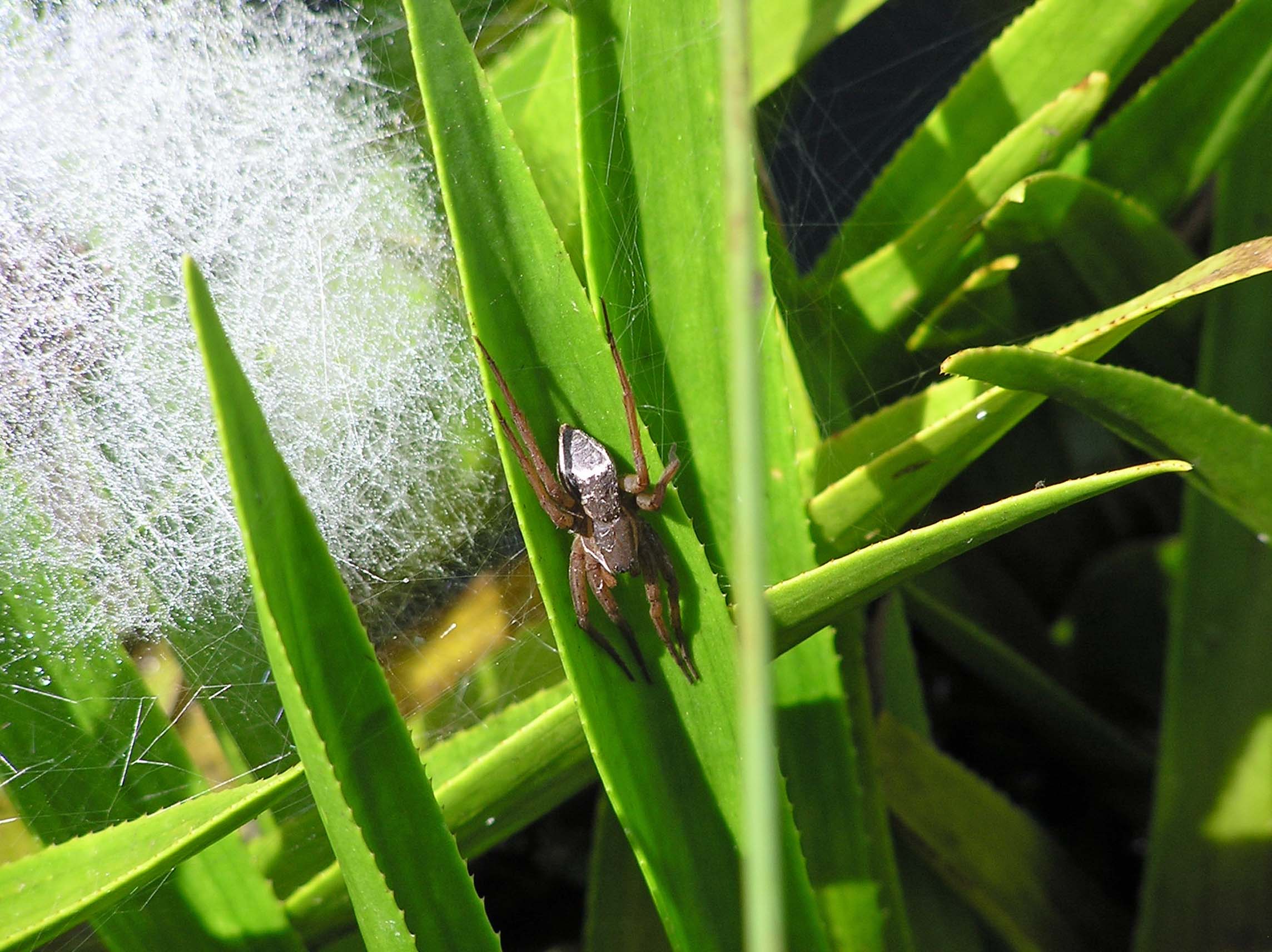
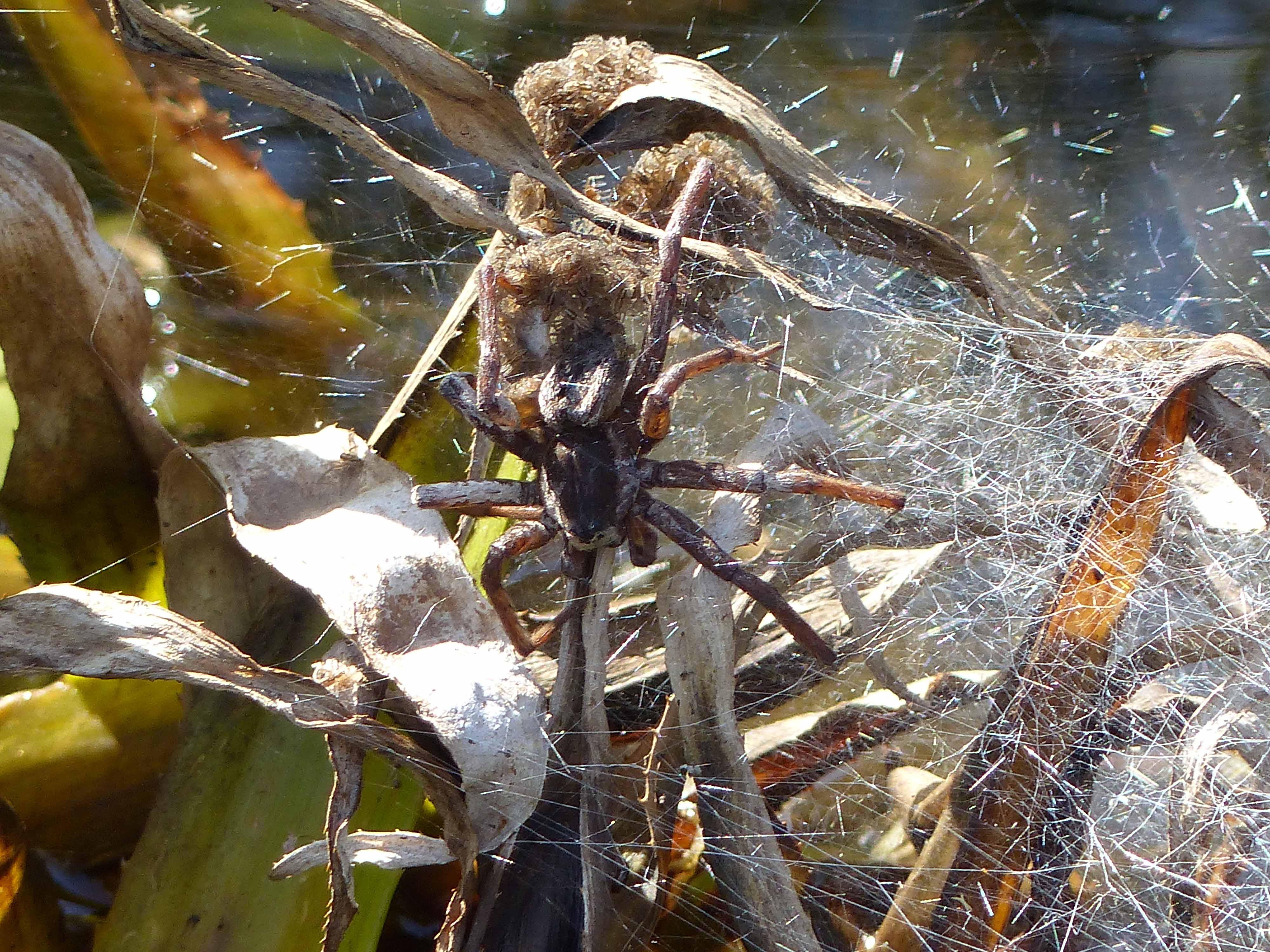
After their first brood of young disperses, the females usually move back to the water surface to resume hunting as their bodies swell with eggs once again. By the time second or third broods are produced, later in the summer, the mothers are usually in conspicuously poor condition. They may have one or more legs missing and their velvety coat of hydrophobic hair appears to have lost condition, perhaps through reduced grooming or wear. White staining of the body, probably by excreted guanine, is very common. Females at this stage often remain at their nursery, sometimes for several weeks, until they die. Late in the season, is not uncommon for females to die while their brood is still in the nursery. There is no evidence that the young cannibalize their mother, whose body is often a collapsed husk by this stage. In captivity, adult females at this stage feed infrequently and die by late autumn, even when they appear to be in good condition.
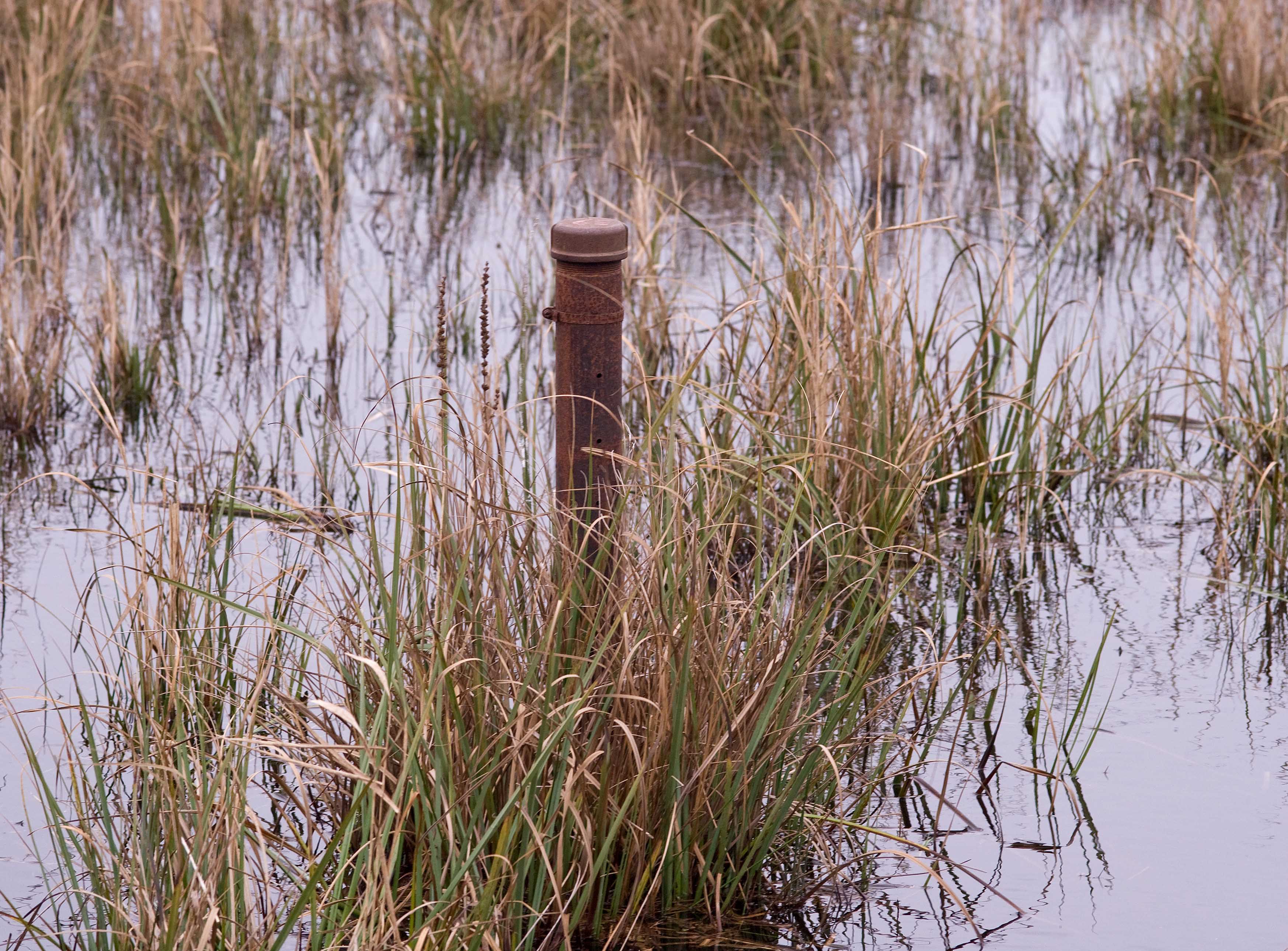
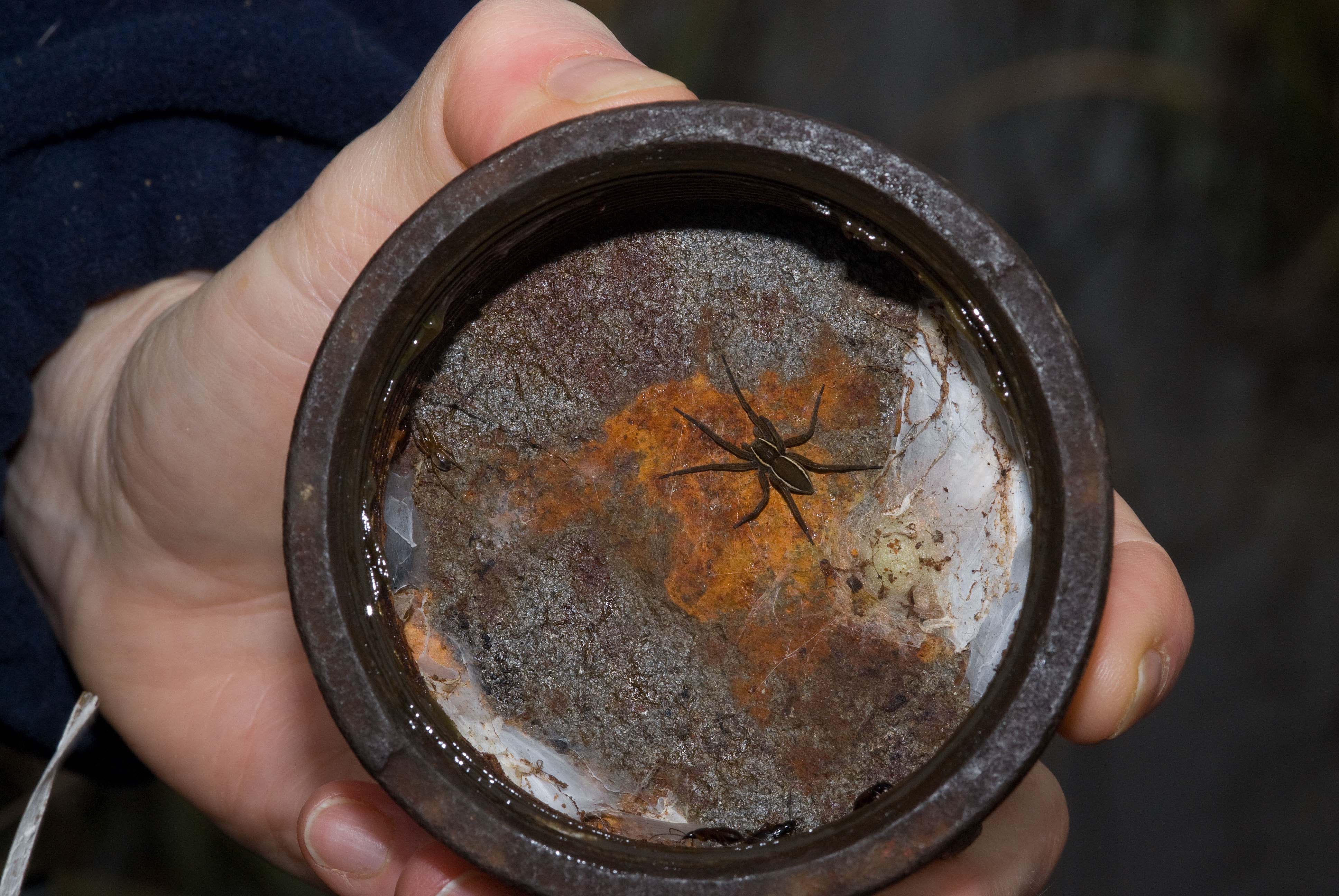
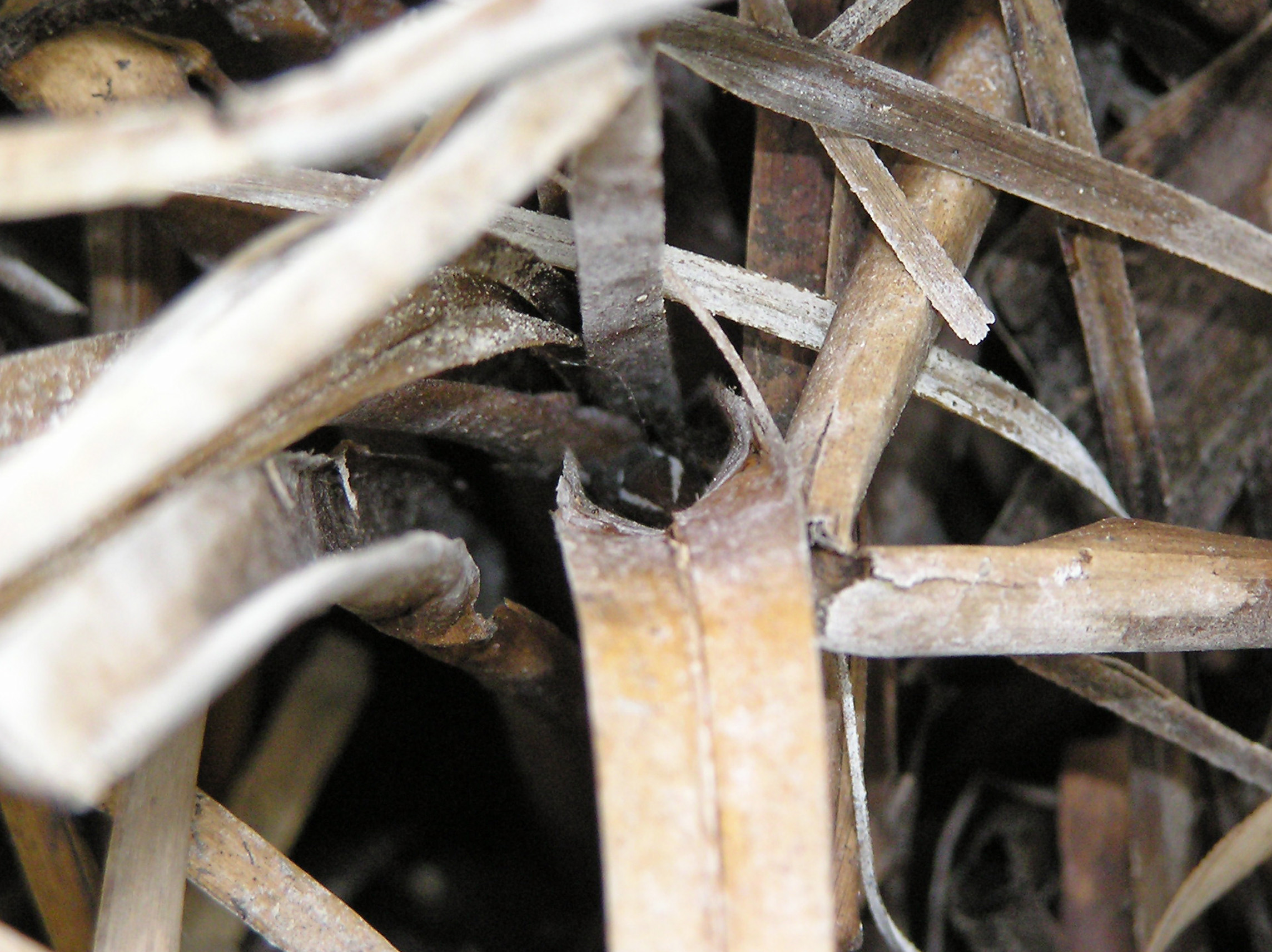
In Britain, juveniles hibernate during their first and second winters although there are relative few winter records and little is known about their hibernation requirements. In sites subject to extensive winter flooding they spend at least some of this period underwater, although they may be able to utilize air pockets under the banks or in the bases of emergent aquatic plants. In grazing marsh ditches torpid D. plantarius have been found close to the surface among dense submergent mats of vegetation. At Redgrave and Lopham Fen they have been found in dipwells - perforated metal tubes used for the measurement of water levels - in severe winter weather. Remarkably, in Germany, this species has been observed with nursery webs in frosty condition in December, something not found to date in Britain. In captivity, the spiders become completely torpid when temperatures are below freezing in winter.
In summer droughts the spiders appear able to undergo a form of aestivation, hiding the hollow stems of aquatic plants until conditions ameliorate.
Moulting
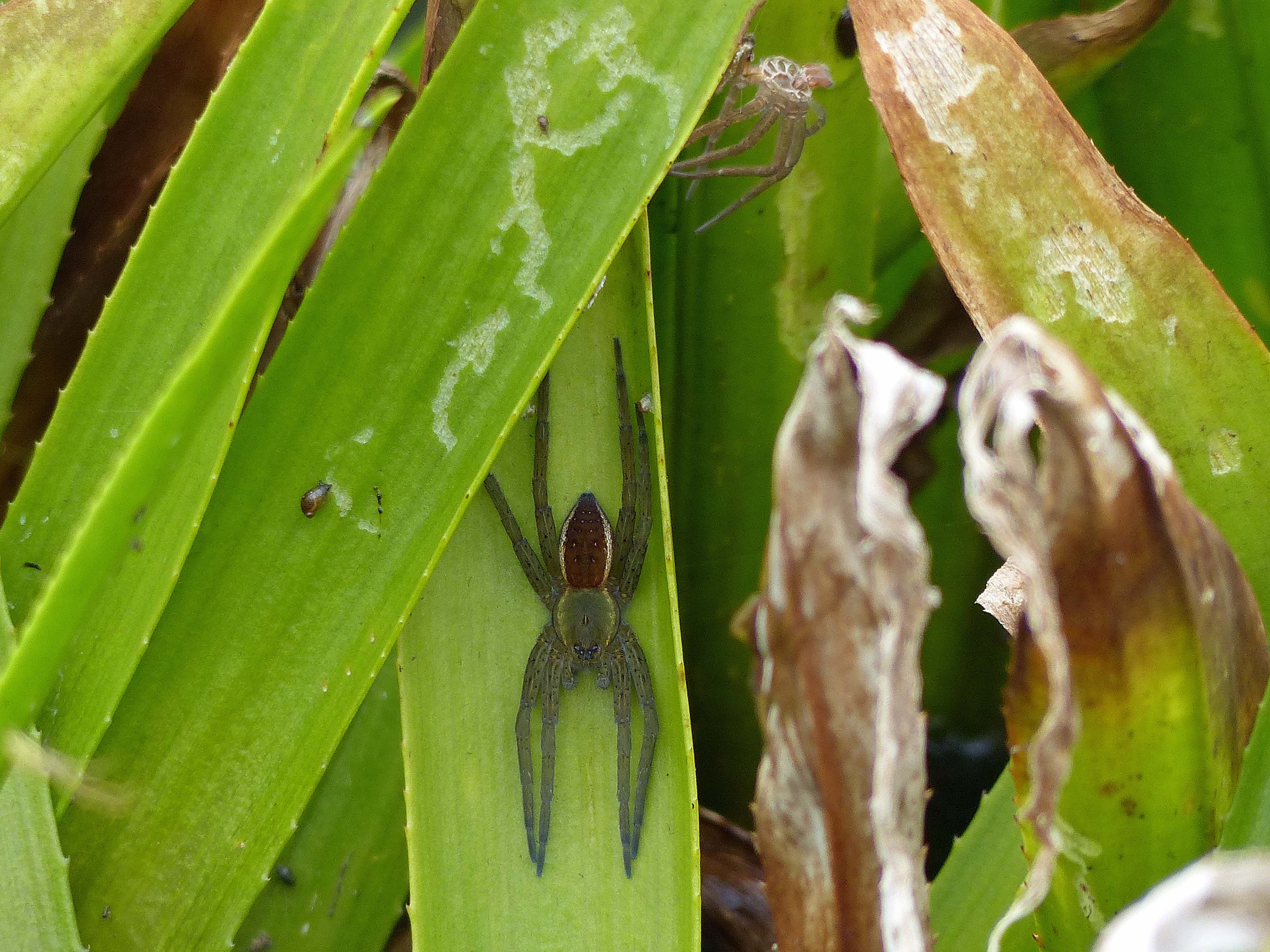
British D. plantarius have been recorded undergoing a maximum of 13 moults between dispersing from the nursery and becoming adult nearly two years later. However, when reared under consistently warm conditions they can mature in one year and the number of moults is reduced. As the time to moult approaches, the spiders loose interest in food for a few days and their legs darken. Just before the moult begins, they hang suspend from emergent vegetation by a short silk line attached to emergent vegetation, and usually hidden to reduce their vulnerability to predators. The legs and cephalothorax of newly-moulted D. plantarius have a distinctly green tinge.
Moult is an intrinsically risky process. In captivity, problems during moulting are the commonest causes of death. If the process is not completed rapidly, limbs become stuck in the old skin or, if withdrawn successfully, they are curled, preventing normal movement. Many spiders species with injuries to their limbs can excise (appendotomise) them either prior to moult either by an internal mechanism that separates the joints (autotomy) or by biting them off (autotilly) (Roth & Roth 1984). Autotilly has been observed in D. plantarius in captivity and avoids the difficulty in withdrawing deformed limbs from the old skin. Loss of legs is common in the wild - they are shed easily if grabbed by a predator, breaking at the weakest point, between the coxa and trochanter, close to the body. When a limb is lost, a new one develops within the coxa and uncoils as a normal, but atypically short, limb after the next moult. The new limb grows with each succeeding moult. Bonnet (1930) reported that, after the first moult following appendotomy in D. fimbriatus, the new leg emerged at about half normal size. It regained normal size after a second moult. Once adult, the spiders are no longer able to regenerate lost limbs. Their ability to function with missing limbs is remarkable though - adult females with only three remaining legs have been seen guarding nurseries.
References
Baillie, A. L., Baillie, S. R. & Smith, H. 2019. The heritability of lateral banding in Dolomedes plantarius. Arachnology 18: 237-244.
Pearson, P. 2008. The ecology and conservation of the Fen Raft Spider (Dolomedes plantarius) in the UK. Ph.D. thesis, University of East Anglia.
Roth, V. D. & Roth, B. M. 1984. A review of appendotomy in spiders and other arachnids. Bulletin of the British Arachnological Society 6: 137-146.
Vugdelić, M. 2006: Genetic relations within and amongst Dolomedes aquatic spiders. Ph.D. thesis, University of East Anglia.
